Karl Shuker's Blog, page 25
August 13, 2017
SPOUTING FORTH ABOUT THE GARGOUILLE - A LETHAL WATER-SPURTING DRAGON FROM THE SEINE
 Flooding the land with limitless liquid, France's water-spouting gargouille was just as deadly as its more familiar fire-breathing brethren (public domain)*
Flooding the land with limitless liquid, France's water-spouting gargouille was just as deadly as its more familiar fire-breathing brethren (public domain)*When preparing my first book on dragons, Dragons: A Natural History , published in 1995, and in which I retell the myths and legends surrounding a wide variety of different dragons, I was particularly anxious to uncover the history of the example featured here in this present ShukerNature blog article. For despite having read many books and articles on dragons down through the years, I had never once seen a detailed account of this specific one.
Thanks, however, to some painstaking but rewarding library-based research (i.e. long before the internet had transformed into the limitless online fund of facts that it is today), I finally pieced together its thrilling story, first recorded in 1394, which I duly recounted in my book. Due to space considerations, unfortunately, my coverage needed to be abridged slightly for publication, but now, for the first time anywhere, I have great pleasure in presenting the original, unabridged version. So here is my full retelling of the rise and fall of one of dracontology's most memorable subjects – the very formidable water-spouting gargouille of France.
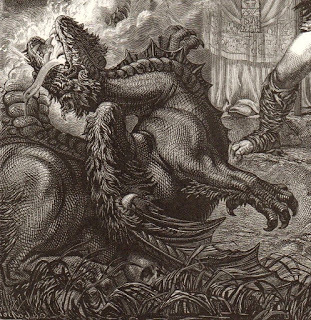 Detail featuring the gargouille from an 1862 engraving – see later here for the entire engraving (public domain)
Detail featuring the gargouille from an 1862 engraving – see later here for the entire engraving (public domain)Not all dragons spew flame or noxious vapour - some spout fountains of water, but to equally devastating effect. It was the year 620 AD, and Rouen, majestic capital of Normandy, was under siege - not by a foreign army, not even by some debilitating pestilence, but by something much more menacing, and lethal. It had emerged one pale morning from the waters of the Seine - at first a great scaled head, equipped with slender snout and jaws, heavy brows encircling a pair of nacreous eyes that gleamed like living moonstones, and borne upon a long neck like some strange reptilian swan.
As the waters cascaded down from its shoulders, however, the creature revealed itself to be an aquatic serpent dragon - of colossal, vermiform stature, ensheathed in a fine mail of glaucous scalloping, and sporting only a pair of membranous fins in place of true limbs.
After surveying its surroundings for a few moments, the great monster opened its mouth - and from the depths of its throat a tremendous jet of water sprang forth, engulfing the countryside, on every side, in an immense wave like an inexplicably-displaced oceanic tide.
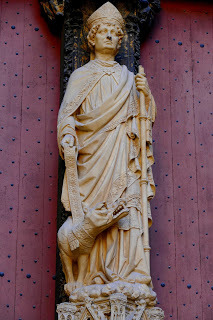 Statue of St Romain at Notre Dame Cathedral in Rouen, France (© Siren-Com/Wikipedia –
CC BY-SA 4.0 licence
)
Statue of St Romain at Notre Dame Cathedral in Rouen, France (© Siren-Com/Wikipedia –
CC BY-SA 4.0 licence
)From that day onwards, this terrifying creature - swiftly dubbed the gargouille ('gargler') by the local populace - mercilessly saturated the land with great fountains of water, until the entire region was imperilled by severe floods. Farmlands were totally devastated, and countless people perished. Many were devoured by the monster, others met their deaths by drowning when it wantonly capsized their boats as they sailed upon the Seine.
St Romain (aka Romanus), archbishop of Rouen, watched this unfolding catastrophe with mounting horror - and knew that he must act swiftly if the land were to be saved from the gargouille's dominion of destruction. Learning that the creature resided in a cave nestling within the Seine's banks, he decided to confront it there, and do whatever was necessary to quell its tyranny forever.
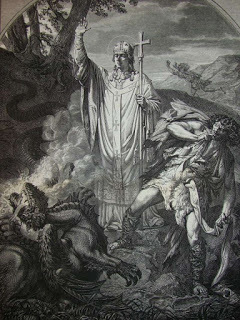 The entire engraving from 1862 portraying St Romain abating the gargouille's power, with the murderer alongside him (public domain)
The entire engraving from 1862 portraying St Romain abating the gargouille's power, with the murderer alongside him (public domain)Yet despite pleading for assistance from the region's besieged inhabitants, St Romain could not elicit the help of anyone to accompany him on his noble quest - until he encountered a prisoner condemned to death for murder. Mindful that his life was already forfeit, the prisoner had nothing to lose by facing a deadly water dragon in its grim lair - which is why he willingly agreed to journey with the archbishop even to what must have seemed like certain death.
Indeed, no sooner had the two brave men reached its cave than the dreadful gargouille appeared - rearing above them with jaws agape as it prepared to disgorge from its mighty gullet a teeming cataract that would blast them away to a cold, watery grave.
 Procession of the gargouille into Rouen following its taming by St Romain – lithograph from c.1840 (public domain)
Procession of the gargouille into Rouen following its taming by St Romain – lithograph from c.1840 (public domain)Even as the lethal tide bubbled upwards in the monster's throat, however, St Romain stepped forward, raised his arms high above their heads - and placed two fingers against one another in the shape of the Cross. Instantly, the dreadful beast sank down, its threatened torrent seeping harmlessly from between its jaws in an insipid trickle, its foaming fury thoroughly extinguished.
So complete was the transformation that the gargouille even allowed St Romain to bind its neck with his stole, enabling the murderer to lead it passively back to Rouen (a scenario readily reminiscent of St Martha's taming of another previously-ferocious French dragon, the tarasque - click here to read all about this six-legged, lion-headed, tortoise-shelled, flame-spurting horror!).
Following the gargouille's arrival, the vengeful townsfolk gathered all around it in droves, intent upon annihilating their onetime persecutor. And in accordance with their demands, the monster was duly put to death - though not by water, but by fire, until only a great heap of ashes remained to testify to its former existence.
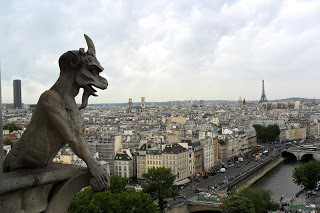 The chimaera gargoyle of Notre Dame de Paris Cathedral, looking across the panorama of Paris, France, far below (public down)
The chimaera gargoyle of Notre Dame de Paris Cathedral, looking across the panorama of Paris, France, far below (public down)These were cast into the Seine, but even today there are ample reminders of the fearsome gargouille. Deriving their name from and sharing their water-spouting talents with this infamous monster are the gargoyles, whose grotesque figures adorn countless churches and other buildings in France and elsewhere around the world. (Incidentally, not all gargoyles do spout water; those that don't are technically referred to as grotesques.)
As for the murderer, whose crime proved to have been the killing of a vicious ruffian who had vilely desecrated his wife, in recognition of his bravery and his loyalty to the archbishop he was pardoned and set free. Moreover, every year thereafter until as recently as 1790, the archbishop of Rouen was permitted by law to pardon one death-condemned criminal each Ascension Day (an act referred to as bishops' privilege).
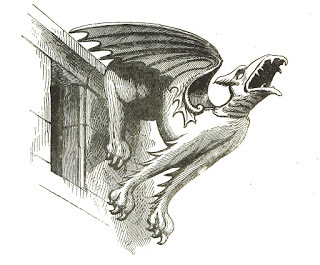 Vintage line drawing of a dragonesque gargoyle (public domain)
Vintage line drawing of a dragonesque gargoyle (public domain)From a strictly cryptozoological viewpoint, I can't help but wonder whether this legend was inspired at least in part, perhaps, by sightings of some cetacean such as a dolphin or small whale that may have conceivably found its way from the sea into the Seine, where such a creature, spurting forth from its blow-hole(s), would undoubtedly have attracted attention and possibly not a little wonder and fear from observers not previously familiar with such a beast. Alternatively, the entire legend may have been created specifically to enhance the standing of St Romain - as exemplified by those associated with St George and St Martha, it is by no means unknown for monster-featuring stories to be linked to saints, in which the latter confronts and conquers the monster, as a potent allegory of good vanquishing evil.
* This article-opening engraving actually depicts a sea serpent of the Heuvelmans super-otter category that was allegedly sighted on 6 July 1734 by Hans Egede, a Scandinavian Lutheran missionary, while on board his ship off the coast of Greenland - and not the river-inhabiting gargouille of France. However, the sea serpent's appearance as depicted in this engraving accords well with traditional descriptions of the gargouille - far better, in fact, than any image officially representing the gargouille that I have ever seen. Consequently, I have chosen to use it in this capacity here, and I did so in my 1995 dragons book too.
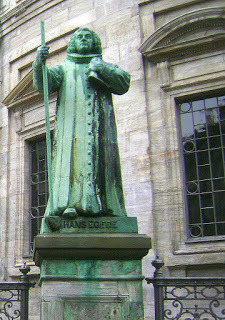 Statue of Hans Egede by August Saabye, at Marmorkirken in Copenhagen, Denmark (public domain)
Statue of Hans Egede by August Saabye, at Marmorkirken in Copenhagen, Denmark (public domain) For further dragon-related folklore and facts, please be sure to check out my two dragon books – Dragons: A Natural History , and Dragons in Zoology, Cryptozoology, and Culture .
Published on August 13, 2017 07:52
August 11, 2017
FLYING PIGS - IN PURSUIT OF PIGASUS AND OTHER PORKERS ON THE WING!
 Behold, Pigasus! (public domain)
Behold, Pigasus! (public domain)"The time has come," the Walrus said,
To talk of many things:
Of shoes - and ships - and sealing-wax -
Of cabbages - and kings -
And why the sea is boiling hot -
And whether pigs have wings."
Lewis Carroll - Through the Looking-Glass
Some time ago, in a previous ShukerNature blog article (click here to read it), I wrote about flying elephants – as you do. So it was only ever going to be a matter of time before I followed that up with an article on flying pigs – and here it is.
When I was a child, and sometimes even as an adult, if ever I voiced an idea that she considered highly implausible, or overly fanciful (even by my normal standards!), my mother Mary Shuker would often give me a certain, very specific half-smile, her eyes dancing with humorous laughter, and say: "Yes, and pigs might fly!".
In one form or another, that expression, and its meaning as used by Mom, has been around for a very long time. Indeed, it possibly originated as "Pigs fly in the ayre with their tayles forward" – a rejoinder denoting amused or sarcastic disbelief, and appearing in a list of proverbs within the 1616 edition of John Withals's English-Latin dictionary A Shorte Dictionarie for Yonge Begynners.
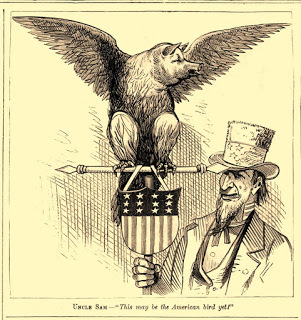 Satirical American political news illustration from 1884 featuring Uncle Sam alongside the flying pig motif in its typical representation of something highly implausible if not downright impossible (public domain)
Satirical American political news illustration from 1884 featuring Uncle Sam alongside the flying pig motif in its typical representation of something highly implausible if not downright impossible (public domain)In any event, just like the fictitious beast known as the hippogriff initially was, it is synonymous nowadays with anything extremely doubtful or impossible to exist, or at least be even remotely likely to do so. Hence it is an example of a specific type of figure of speech known as an adynation (and for my ShukerNature coverage elucidating this conceptual link to the hippogriff, please click here ).
Nevertheless, one of the numerous telling lessons in life that I've learnt by way of investigating cryptozoological cases is that if you look long enough and hard enough – and sometimes if you don't actually look at all – even the most implausible and unlikely things will be found. And so indeed it has been with flying pigs and other porkers on the wing, as will now be seen.
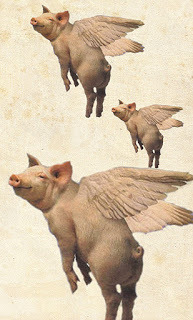 Pigs with wings – impossible things? (Image found abundantly online, but its creator and © owner are currently unknown to me, despite having made extensive searches – reproduction here on a strictly educational, non-commercial Fair Use basis only)
Pigs with wings – impossible things? (Image found abundantly online, but its creator and © owner are currently unknown to me, despite having made extensive searches – reproduction here on a strictly educational, non-commercial Fair Use basis only)The first instance of an allegedly airborne entity of the porcine persuasion that I ever encountered, and which is still the most perplexing to me, featured in a short report from 1905 briefly paraphrased in Living Wonders: Mysteries and Curiosities of the Animal World – a unique and thoroughly fascinating compendium of reports and analyses concerning all manner of anomalous animals and animal anomalies compiled by veteran Fortean writer-researchers John Michell and Bob Rickard, and first published in 1982 (a much-expanded, fully-revised edition appeared in 2000, entitled UnexplainedPhenomena: A Rough Guide Special, which combined Living Wonderswith an earlier book written by the same authors, Phenomena, published in 1977, but, sadly, did not include any flying pigs within its pages).
I subsequently discovered a more detailed documentation of this very curious case in New Lands (1923) – one of the tomes in pioneering anomalies chronicler Charles Fort's peerless tetralogy documenting and passing comment upon all manner of unconventional occurrences.
 Charles Fort (public domain)
Charles Fort (public domain)Here is what Fort wrote:
Sept. 2, 1905—the tragedy of the space-pig:
In the English Mechanic, 86-100, Col. Markwick writes that, according to the Cambrian Natural Observer, something was seen in the sky. at Llangollen, Wales, Sept. 2, 1905. It is described as an intensely black object, about two miles above the earth's surface, moving at the rate of about twenty miles an hour. Col. Markwick writes: "Could it have been a balloon?" We give Col. Markwick good rating as an extra-geographer, but of the early, or differentiating type, a transitional, if not a sphinx: so he was not quite developed enough to publish the details of this object. In the Cambrian Natural Observer, 1905-35 — the journal of the Astronomical Society of Wales — it is said that, according to accounts in the newspapers, an object had appeared in the sky, at Llangollen, Wales, Sept. 2, 1905. At the schoolhouse, in Vroncysylite [= the village of Froncysyllte, or Fron for short]…the thing in the sky had been examined through powerful field glasses. We are told that it had short wings, and flew, or moved, in a way described as "casually inclining sideways." It seemed to have four legs, and looked to be about ten feet long. According to several witnesses it looked like a huge, winged pig, with webbed feet. "Much speculation was rife as to what the mysterious object could be."…
I don't know that my own attitude toward these data is understood, and I don't know that it matters in the least: also from time to time my own attitude changes: but very largely my feeling is that not much can be, or should be, concluded from our meager accounts, but that so often are these occurrences, in our fields, reported, that several times every year there will be occurrences that one would like to have investigated by someone who believes that we have written nothing but bosh, and by someone who believes in our data almost religiously.
One can readily understand and sympathise with Fort's evident bemusement at such a report. After all, how can a supposed sighting of a very sizeable pig with wings and webbed feet flying through the sky be rationally explained if not an outright hoax or a misidentification of truly monstrous proportions? To my knowledge, no similar creature has been reported above Wales (or, indeed, anywhere else) since then, so whatever this veritable Pigasus was, at least it wasn't breeding – which is a mercy in itself!
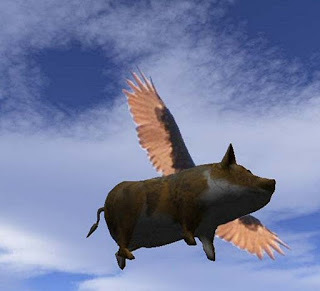 Might the Welsh flying pig have looked something like this? (public domain)
Might the Welsh flying pig have looked something like this? (public domain)Had its one-off appearance taken place at some rather later date, I might have suggested that Wales's wayward Pigasus could have been some kind of man-made object that had originally been produced to feature in some form of advertising campaign but which had broken free from its tethering bonds and absconded skywards – if only because one such ostensibly unlikely incident featuring an airborne pig actually did occur.
On 4 December 1976, an article documenting this incident's bizarre events of the previous day, written by Clive Borrell, featured in Britain's most respectable, and respected, newspaper – London's daily broadsheet The Times. And the precise subject of that article? An enormous pink pig floating at an altitude of 7,000 ft and causing a very real, if decidedly surreal, hazard to aircraft!
Reports of this identified yet highly unexpected flying object, originating from unbelieving pilots, had found their way to police at London's Scotland Yard, as noted by Borrell in his article. And when he asked one of the Yard's representatives for more details, this is what he was given:
"At 10.25 this morning [3 December] a pink pig balloon measuring 10 metres by five metres [just over 30 ft by 15 ft], escaped from its mooring in the car park of Battersea power station. It was there to advertise the pop group, Pink Floyd, but it broke loose.
One of our helicopters on traffic patrol intercepted a radio message from a light aircraft to the control tower at Heathrow airport. The pilot was heard to say: "I've just been overtaken by a pink elephant at 7,000 ft."
The helicopter crew offered to help because the control tower could not plot the creature on their radar.
…We escorted it across London as far as Crystal Palace. Now it's out of our area."
Wisely ignoring the above-quoted pilot's evidently poor zoological knowledge in confusing a pig with an elephant, Borrell went on to note that by midday the huge hog-shaped balloon (filled with helium) was 20 miles east of London, passing over the Essex suburbs, and that the Civil Aviation Authority was very amused indeed by this unheralded sky beast.
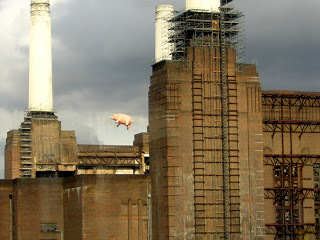 How it must have looked when the floating pig balloon broke free – this photo is actually of the pig's return in September 2011 – see later for details (© Christopher Hilton/Wikipedia -
CC BY-SA 2.0 licence
)
How it must have looked when the floating pig balloon broke free – this photo is actually of the pig's return in September 2011 – see later for details (© Christopher Hilton/Wikipedia -
CC BY-SA 2.0 licence
)Later that day, Essex police reported that the pig was beginning to lose height, drifting now at an altitude of only 5,000 ft – perhaps it was hungry, they speculated. But by mid-afternoon it had clearly regained strength, and altitude, soaring majestically now at a height of 18,000 ft above Chatham, and seemingly heading towards continental Europe. Might it therefore be not so much a homing pigeon as a homing pig, making its way back to Germany, where it was originally manufactured?
Tragically, we shall never know, because several hours later, as revealed by Borrell in his Times article, the pig began to deflate and eventually came down that same evening to land on a farm at Chilham, near Canterbury, Kent, its escape to victory thwarted, its great adventure ended. In all seriousness, however, its danger to aircraft had been deemed sufficiently severe for flights at Heathrow Airport, London's biggest, to be cancelled.
(As a brief digression, I should note here that I didn't see Borrell's article when it was originally published in December 1976, but came upon it a decade later, reprinted within a wonderful compendium of Timesarticles. published in 1985, which had been compiled by Stephen Winkworth, and was entitled More Amazing Times! Moreover, I was so delighted to see this article that I actually purchased the entire book just to have it, because I knew that one day I'd be able to make use of it – and now, albeit many years later, that day has finally come!)
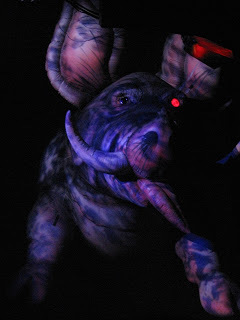 Floyd Pig, the embodiment of Pink Floyd's album, Animals, where the Pigs take over in a George Orwellian world - backdrop from a Pink Floyd concert tour (© Craig Carper/Wikipedia -
CC BY-SA 2.0 licence
)
Floyd Pig, the embodiment of Pink Floyd's album, Animals, where the Pigs take over in a George Orwellian world - backdrop from a Pink Floyd concert tour (© Craig Carper/Wikipedia -
CC BY-SA 2.0 licence
)Researching this marvellously memorable incident, I uncovered certain additional details, which are as follows. As all Pink Floyd fans will instantly confirm, the purpose of this giant inflatable pig – which had been officially dubbed Algie by the band – was to advertise and appear upon the cover of their latest album, Animals, released in 1977, and which does indeed feature a photograph of it, floating between two of Battersea Power Station's chimneys – the photo being produced after Algie had been recovered, repaired, and reinflated. Three of the five tracks on Animals feature pigs in their titles.
Algie had been built by the artist Jeffrey Shaw, assisted by design team Hipgnosis, after being designed by Floyd bassist and songwriter Roger Waters. Algie subsequently appeared at a number of Pink Floyd concerts, originally still pink in colour, but later black. After Waters quit Pink Floyd in 1985, he continued to feature inflatable pigs in many of his solo concerts, often brightly adorned with slogans, and sometimes deliberately released into the sky.
 Two views of flying slogans-inscribed pig from Roger Waters show at Hollywood Bowl on 13 June 2007(© BeautifulFlying/Wikipedia -
CC BY-SA 3.0 licence
)
Two views of flying slogans-inscribed pig from Roger Waters show at Hollywood Bowl on 13 June 2007(© BeautifulFlying/Wikipedia -
CC BY-SA 3.0 licence
)On 26 September 2011, an Algie replica was securely tethered over Battersea Power Station and photographed to promote the band's reissuing of their first 14 studio albums via their Why Pink Floyd…? re-release campaign. And a pig floating above the station was also glimpsed in British movie director Danny Boyle's much-acclaimed Isles of Wonder short film shown as part of the Opening Ceremonies of the 2012 Summer Olympics held in London, UK.
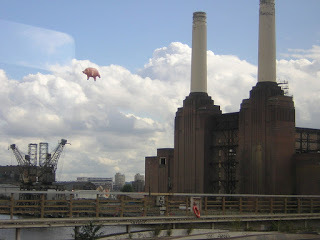 Giant pig balloon flying over Battersea Power Station, 26 September 2011, as part of Pink Floyd's Why Pink Floyd...? re-release campaign (© Bex Walton/Wikipedia -
CC BY 2.0 licence
)
Giant pig balloon flying over Battersea Power Station, 26 September 2011, as part of Pink Floyd's Why Pink Floyd...? re-release campaign (© Bex Walton/Wikipedia -
CC BY 2.0 licence
)Clearly, old flying pigs never die, they just keep floating on…
Speaking of old flying pigs: there are records on file concerning such exotica that date surprisingly far back in time. Take, for instance, the intriguing American account that appeared in The History of New England, 1630-1649, written by English Puritan explorer John Winthrop, who settled in Massachusetts during 1630 and became the Governor of Massachusetts Bay Colony. The above-cited book is a transcription of his original notes, and was published in 1908. In it can be found the following passage:
In this year one James Everell, a sober, discreet man, and two others, saw a great light in the night at Muddy River. When it stood still, it flamed up, and was about three yards square; when it ran, it was contracted into the figure of a swine: it ran as swift as an arrow towards Charlton, and so up and down about two or three hours.
Not so much ball lightning as boar lightning, it would seem. One for the meteorologists rather than the mammalogists to ponder over, I suspect.
 Portrait of John Winthrop (public domain)
Portrait of John Winthrop (public domain)As ShukerNature readers will already be aware, medieval illuminated manuscripts have long fascinated me, because of the extraordinary diversity of bizarre beasts painstakingly portrayed around the margins of their text (as inscribed upon unbound, usually double-sided pages known as folios, whose upper side or verso is usually abbreviated to v, and whose lower side or recto as r). Known as marginalia grotesques, they occur in every imaginable, and often entirely unimaginable, form. I have already documented some of these extraordinary creatures here (snail-cats and other malacomorphs), here (an elephant rat), here (a Star Wars Yoda-lookalike), and here (a very sinister, sharp-toothed Nosferatu doppelgänger).
Was it possible, therefore, that one or two pigs with wings might also be found lurking among the illuminated letters of such manuscripts, quite literally hogging the limelight? There was only one way to find out, and that was to peruse a representative selection of them (happily, many of the most famous of these exquisite medieval works are present in fully-scanned form online). So that's what I did – and two delightful examples were duly uncovered.
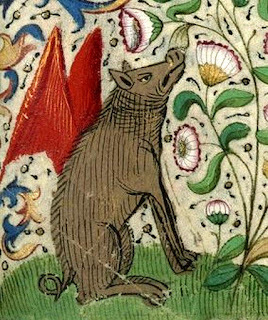 Winged pig from Le Livre des Hystoires du Mirouer, Depuis la Création, Jusqu' Après la Dictature de Quintus
Cincinnatus
(Bibliothèque Nationale de France/public domain)
Winged pig from Le Livre des Hystoires du Mirouer, Depuis la Création, Jusqu' Après la Dictature de Quintus
Cincinnatus
(Bibliothèque Nationale de France/public domain)One of these, a somewhat belligerent boar with a pair of bright red bat-like wings, turned up in Le Livre des Hystoires du Mirouer, Depuis la Création, Jusqu' Après la Dictature de Quintus Cincinnatus, a beautiful illuminated manuscript dating from the 15th Century and consisting of 41 folios. It is currently held at the Bibliothèque Nationale de France, where it is listed as BNF Fr 328. The winged pig is present in the bottom left-hand corner of the margin on f 29 v (i.e. on the verso side of folio 29).
The other one, sporting a pair of proportionately larger, elaborately pleated wings, was present in the Katherine Hours, an illuminated Book of Hours (click here for details of what these are) dating from around 1480-1485. A lavishly-illustrated illuminated manuscript consisting of over 100 folios, it was created at Tours in France by Jean Bourdichon (1457-1521), who was court painter to four successive French kings. It is held at the J. Paul Getty Museum, and earns its name from the intertwined initials 'I' and 'K', which appear frequently in the borders of the manuscript, with the 'I'embraced by a loop that forms the arms of the 'K'. As noted by the museum's online page devoted to this manuscript, the letters are likely to be the initials of a husband and wife who commissioned it. The 'K' probably stands for Katherine, because the manuscript contains several prayers to Saint Catherine of Alexandria, after whom women in medieval France were often named. The winged pig appears in the middle of the right-hand margin of folio 83, whose principal feature is a large central illustration entitled 'The Man of Sorrows at the Last Judgement'.
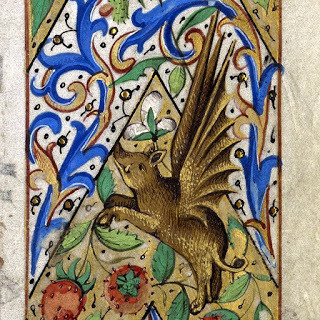 Winged pig from the Katherine Hours (J. Paul Getty Museum/public domain)
Winged pig from the Katherine Hours (J. Paul Getty Museum/public domain)As for the purposes of these and other zoological grotesques, I noted in my previous ShukerNature articles regarding such entities that it is very likely that many were created by the monks producing illuminated manuscripts as humorous or even slyly rebellious adornments that also helped them to break or lighten the very lengthy periods of excessive tedium endured throughout the very painstaking process involved in the preparation of such manuscripts.
Moving forward to the present day, greatly deserving of mention here is a very different but equally eyecatching commemoration of winged pigs in art. Namely, the quartet of statues known as the Cincinnati Flying Pigs with the Fish Head Shrouds, each statue standing 4.5 ft tall, perched atop a smokestack column, and with a fish head shroud sending forth a golden cable attached to the column. Created by the Doug Freeman Studio, they were commissioned by Andrew Leicester with the Cincinnati Contemporary Art Museum, as part of the entry for the Sawyer Point Park, in Cincinnati, Ohio.
Cincinnati has long been nicknamed Porkopolis, due to its historical importance as a major centre of the American pig industry, so if winged pigs were ever going to appear anywhere in the USA, this was always where they would do so. Furthermore, during the Big Pig Gig of 2000 and the Big Pig Gig: Do-Re-Wee of 2012, events organised by a community employment programme called ArtWorks, numerous life-sized fibreglass pig statues of varying forms and colours were temporarily installed throughout Cincinnati's downtown area, and many of these were winged pigs.
Another spectacular work of art is the painting Fliegende Schweine ('Flying Pigs'), produced by the acclaimed modern-day German artist, designer, and sculptor Michael Maschka, a leading follower of the Fantastic Realism school of art.
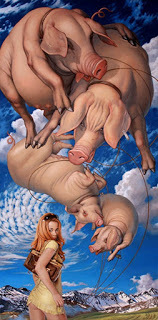 Fliegende Schweine
, by Michael Maschka (© Michael Maschka/Wikipedia -
CC BY-SA 3.0 licence
)
Fliegende Schweine
, by Michael Maschka (© Michael Maschka/Wikipedia -
CC BY-SA 3.0 licence
)Sadly, flying pigs have not featured extensively in mythology, so often a sanctuary for esoteric entities of the zoological variety. Perhaps the most notable example, occurring in Greek mythology, is Chrysaor. Resulting from a liaison between Medusa (in her ravishing pre-gorgon days) and the sea god Poseidon (having assumed mortal human form at the time), he is variously depicted as a young human giant or a great winged boar. However, he was not born until Medusa was beheaded by Perseus, arising from drops of blood seeping from her neck stump. By a peculiar quirk that is so often the norm amid the bizarre biology all too prevalent in myths and legends, Chrysaor's twin brother was none other than that noble winged steed Pegasus, who was also born from slain Medusa's blood according to some versions of this tale.
Certain items of ancient Greek ware depict Chrysaor. These most famously include an Athenian black-figure pyxis vase portraying him as a young human boy, and dating from c.525-475 BC, which is housed in the Louvre Museum, Paris, France; and an Athenian red-figure kylix vase portraying him as a winged boar on the shield of his son, the three-bodied giant Geryon, and dating from c.510-500 BC, which is housed at the Staatliche Antikensammlungen (State Collections of Antiquities), a major archaeological museum in Munich, Germany.
Less familiar is the winged sow that according to the Greek-speaking Roman scholar Aelian (c.175-235 AD), writing in his 3-volume work On Animals, once terrorised the ancient Greek city of Clazomenae, whose ruins can be found in what is now the Anatolian Turkish town of Urla. Originally situated on the mainland, Clazomenae was subsequently moved to an island just off the coast, lying west of what was then the Greek city of Smyrna, but is now the Anatolian city of Izmir.
 A flying pig used as a trademark by Baldwin, Farnum & Shapleigh, as seen on this bill of sale from 1875 (public domain)
A flying pig used as a trademark by Baldwin, Farnum & Shapleigh, as seen on this bill of sale from 1875 (public domain)Flying pigs sometimes occur as publicity emblems, as seen earlier here with Pink Floyd. Other notable examples of such use include serving as the official mascot for the Grand Prairie Airhogs (a semi-professional baseball team from Grand Prairie in Texas), as the logo of the Flying Pig Brewing Co in Everett, Washington (in operation as a microbrewery or brewpub from 1997 to 2005), and as the official mascot for the Chesapeake Bay log canoe Edmee S. In addition, the presence of flying pigs featured in many promotional posters for the fantasy movie Nanny McPhee and the Big Bang (2010), and it goes without saying that there are a fair few Flying Pig pubs, hotels, and restaurants worldwide.
Much as I would love to do so, I cannot lay claim to having invented the name 'Pigasus' – frustratingly, that singular honour(?) must go to children's author Ruth Plumly Thompson. For it was she who included a flying winged pig of that name in various of the 21 novels written by her during the 1920s, 1930s, and 1970s that were sequels to the 14 original Oz books authored by L. Frank Baum. Pigasus first appeared in Thompson's Pirates in Oz (1931), but played a much bigger role in The Wishing Horse of Oz (1935).
Pigs with wings that can fly evidently have great appeal for youngsters, because they have also occurred in a number of later, non-Oz children's books. These include Clementina the Flying Pig (1939) by Oskar Lebeck, Perfect the Pig (1980) by Susan Jeschke, Porcellus the Flying Pig (1988) by Judy Corbalis, The History of Flying Pigs (1991) by A.A. Barber, and Cincy the Flying Pig(2016) by Jenniger Elig. Plus, as if flying pigs weren't extraordinary enough already, there is also Herbert the Flying Blue Pig (2015) by Loveleen Bahl.
 John Steinbeck's famous Pigasus emblem (© owner presently unknown to me despite making considerable searches online; reproduced here on a strictly educational, non-commercial Fair Use basis only)
John Steinbeck's famous Pigasus emblem (© owner presently unknown to me despite making considerable searches online; reproduced here on a strictly educational, non-commercial Fair Use basis only)Moreover, the celebrated American novelist John Steinbeck designed a small winged pig emblem that he too dubbed Pigasus, its origin stemming from a dismissive comment made to him long ago by his college professor who was sceptical about his claims that one day he would become a famous writer, replying sarcastically that this would happen only when pigs flew. Consequently, once Steinbeck did achieve fame, he made a point of inscribing Pigasus's image in his books as a personal insignia, along with the cod Latin phrase "Ad astra per alia porci", which he intended to mean "To the stars on the wings of a pig", but which actually translates more closely as "To the stars through other pigs".
(Incidentally, history also records a non-winged Pigasus of note – a 145-lb domestic pig of that name that was nominated for President of the USA on 23 August 1968 by an anti-establishment and countercultural revolutionary group known as the Youth International Party – but that, as they say, is another story entirely.)
 Beautiful wooden winged pig mobile from Bali, which traditionally serves as a spirit chaser (photo appears in uncredited form on numerous websites but its original source is currently unknown to me despite my having made considerable searches - reproduced here on a strictly educational, non-commercial Fair Use basis only)
Beautiful wooden winged pig mobile from Bali, which traditionally serves as a spirit chaser (photo appears in uncredited form on numerous websites but its original source is currently unknown to me despite my having made considerable searches - reproduced here on a strictly educational, non-commercial Fair Use basis only)Based upon the traditional folk belief that they will keep evil spirits at bay while a person is sleeping, chasing them far away, in Bali and certain other Indonesian islands wooden mobiles, intricately carved and beautifully painted in bright colours, are often hung above beds. Equally popular today as exotic souvenirs, these eyecatching mobiles frequently take the form of various familiar animals, but sporting a pair of large detachable wings. Amid my own eclectic menagerie of monsters, mystery beasts, and all manner of magical creatures, I have a Balinese winged toad mobile (click here ) and also a Balinese winged elephant mobile (click here ), but recently I spotted online a photograph (original source unknown) of an exquisite porcine version, resplendent in crimson and gold, and I have since seen photos of others too, in an array of different colours and styles of carving, so the pig is presumably deemed in Indonesia to be a successful spirit chaser.
Last but definitely not least: here is my very own Pigasus, a small but sweet figurine ornament that I purchased from some collector's/bric-a-brac fair many years ago, but which bears no manufacturer's label or identifying details of any kind, so I have no idea of his origin or history. Consequently, if anyone reading this chapter could provide me with any details, I'd be very greatly appreciative. After all, it's not every day that I purchase a pig with wings, so when I do I'd certainly like to know something about him!
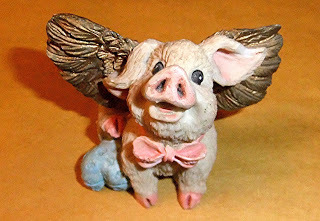 My very own Pigasus – provenance and production details currently unknown (© Dr Karl Shuker)
My very own Pigasus – provenance and production details currently unknown (© Dr Karl Shuker)
Published on August 11, 2017 12:10
August 5, 2017
RECALLING LONDON ZOO'S LIJAGUPARD - THE SUBJECT OF A (VERY) CROSSBRED CONTROVERSY
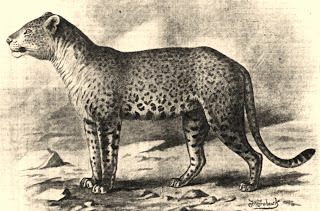 Frederick W. Frohawk's exquisite illustration of the Londonlijagupard (public domain)
Frederick W. Frohawk's exquisite illustration of the Londonlijagupard (public domain)In my previous ShukerNature blog article (click here ), I drew attention to a very remarkable, and extremely sizeable, feline hybrid – Cubanacan the litigon, the result of a successful mating between a lion and a tigon (tiger x lioness hybrid), who was formerly exhibited at Alipore Zoo in Kolkata, India. Now, here is another truly extraordinary episode appertaining to big cat crossbreeding.
It began just over a century ago - with the arrival at London Zoo in 1908 of a singularly mysterious felid that resembled a slim, gracile lioness but was elegantly dappled with large brown rosettes recalling those of the Himalayan snow leopard Uncia uncia! Its owner was J.D. Hamlyn, a London-based animal dealer, who asserted that it had been captured in the Congolese jungles and represented a wholly new species (dubbed a Congolese spotted lion) - a statement that naturally attracted a great deal of media publicity. It was even portrayed in a beautiful drawing prepared by English zoological artist Frederick W. Frohawk, which opens this present ShukerNature article.
However, London Zoo's superintendent, cat expert Reginald I. Pocock, was sceptical of such grandiose claims, and dismissed this feline enigma as a leopard x lion hybrid (leopon), after which it was removed from London to Glasgow. Tragically, it died just a few years later - reputedly killed by a lion that broke through into its cage from a neighbouring enclosure - and was later exhibited as a mounted taxiderm specimen in standing pose (very closely resembling its pose in Frohawk's drawing) at France's National Museum of Natural History in Paris.
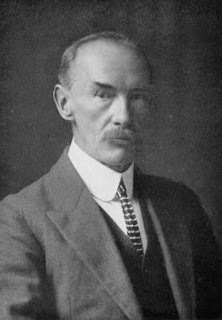 Reginald I. Pocock, a legendary name in British zoology (
Wikipedia
- reproduced here on a strictly educational, non-commercial Fair Use basis only)
Reginald I. Pocock, a legendary name in British zoology (
Wikipedia
- reproduced here on a strictly educational, non-commercial Fair Use basis only)By the early 1930s, the full history of this controversial cat had finally been uncovered, and its extraordinary identity was at last exposed. At the turn of the century a male jaguar had mated with a leopardess at Chicago Zoo, the result of which was a litter of three jagupards (aka jaguleps), one male and two females. All three were later sold to a travelling menagerie, but whereas the male was killed by a lion his two sisters grew to adulthood, and both of them mated with a lion. Remarkably, these matings were viable, yielding several cubs - and it was one of these that found its way to London Zoo, deceitfully billed as a new species.
Bearing in mind that this amazing animal was the complex product of genetic intermingling between three different species of big cat - lion Panthera leo, leopard P. pardus, and jaguar P. onca - it is little wonder that it seemed so exotic in appearance and engendered such confusion. After all, it isn't every day that a lijagupard (aka lijagulep) turns up in London - or anywhere else, for that matter!
This ShukerNature blog article is excerpted from my book Cats of Magic, Mythology, and Mystery , which contains detailed histories of a wide range of feline hybrids, including ligers and tigons, litigons, liligers, and titigers, leopons and lipards, jaglions, pumapards, jagupards, and many others too.
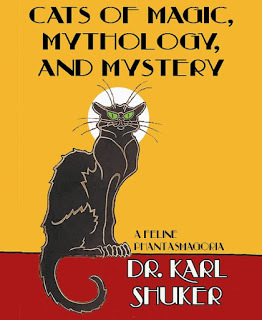
Published on August 05, 2017 19:34
August 2, 2017
CUBANACAN THE LITIGON - REDISCOVERING A LONG-LOST PHOTOGRAPH OF A TRULY REMARKABLE HYBRID BIG CAT
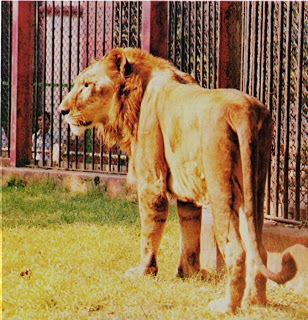 The rediscovered photograph of Cubanacan the litigon, seen here fully grown (© Alipore Zoo, reproduction courtesy of Dr Ashish Kumar Samanta and Ms Piyali Chattopadhyay Sinha, respectively the Director and the Deputy Director of Alipore Zoo, Kolkata)
The rediscovered photograph of Cubanacan the litigon, seen here fully grown (© Alipore Zoo, reproduction courtesy of Dr Ashish Kumar Samanta and Ms Piyali Chattopadhyay Sinha, respectively the Director and the Deputy Director of Alipore Zoo, Kolkata)On 22 May 2017, I brought to the attention of celebrated Indian naturalist Shubhobroto S. Ghosh – currently Wildlife Project Manager of World Animal Protection in India – a colour photograph hitherto deemed long-lost that depicts a truly extraordinary hybrid big cat. The cat in question is Cubanacan, a male litigon (or li-tigon), i.e. the progeny of a lion and a female tigon (tiger x lioness hybrid), shown fully grown in the rediscovered photo. He was born at Alipore Zoo in Kolkata, India, on 7 March 1979, and was the only surviving cub of his litter of three. Cubanacan was also once the world’s largest big cat in captivity, who, according to an entry in the 1985 edition of the Guinness Book of Records, weighed 363 kg (800 lb), stood 1.32 m (4 ft 4 in) at the shoulder, and measured 3.5 m (11.5 ft) in length. Moreover, it was in that particular edition that I had rediscovered the photograph (credited there to Calcutta Zoo, i.e. Alipore Zoo), whose reproduction in it had apparently not been known about by other researchers seeking any existing Cubanacan images (this may be due to the photo seemingly appearing only in this one edition, for 1985, not in any of those for earlier or later years), and which was not even present in the archives of its originator, Alipore Zoo.
Given the present-day aversion to hybridisation occurring in captivity, and the ban imposed in 1985 on crossbreeding big cats in India, it appears that Cubanacan’s memory was purposely forgotten. Yet the hybridisation debate in biology is important. So too is the current proposal on banning big cat hybridisation in the USA. Consequently, it is in the light of such controversies that this rediscovered photograph of Cubanacan has now been preserved for posterity as a valuable item in wildlife history, best viewed without value judgement, by having been included within a major new photo story article* published online by Nature India (please click here to read it). Authored by myself and Shubhobroto, it constitutes both the most comprehensive and the most extensively-illustrated account of Cubanacan's history ever produced.
 Photograph of Cubanacan the litigon snapped when he was just one year old, in The Statesman, Calcutta (now Kolkata), 12 March 1980 (© The Statesman, Calcutta (now Kolkata), reproduced here on a strictly educational, non-commercial Fair Use basis only)
Photograph of Cubanacan the litigon snapped when he was just one year old, in The Statesman, Calcutta (now Kolkata), 12 March 1980 (© The Statesman, Calcutta (now Kolkata), reproduced here on a strictly educational, non-commercial Fair Use basis only)* SHUKER, Karl and GHOSH, Shubhobroto, 'Nature India Photo Story: Cubanacan the Litigon', Nature India - Indigenus, http://blogs.nature.com/indigenus/2017/08/nature-india-photo-story-cubanacan-the-litigon.html?WT.mc_id=FBK_NPG 1 August (2017).
Hope yet for the alleged missing thunderbird photograph (click here to read all about it)? Further proof at least that long-lost photos of unusual animals CAN be rediscovered (also, click here to read about my part in rediscovering the long-overlooked Trunko photographs).
Cubanacan, together with a vast diversity of other fascinating feline hybrids, including ligers, pumapards (also click here ), leopons (also click here ), titigons, liligers, jaguleps, litards, pantigs (click also here ), servicals (click also here ), and even an extraordinary three-species hybrid dubbed a lijagupard, also features in my book Cats of Magic, Mythology, and Mystery .
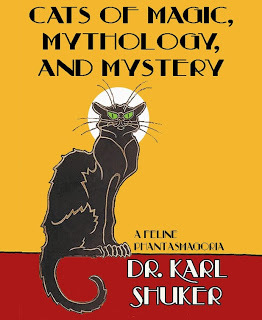
Published on August 02, 2017 12:28
July 30, 2017
A PICTURE OF MONKEY BUSINESS - OR, HOW A SMALL FURRY PET BECAME A GIANT MYSTERY APE. PART 2: THE TRUE HISTORY OF AMERANTHROPOIDES LOYSI
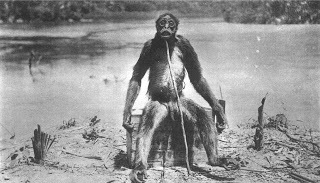 The uncropped version of Dr François de Loys's photograph of the supposed South American ape Ameranthropoides loysi – one of the most controversial cryptozoological images of all time (public domain)
The uncropped version of Dr François de Loys's photograph of the supposed South American ape Ameranthropoides loysi – one of the most controversial cryptozoological images of all time (public domain)Welcome to my 600th post on ShukerNature! Befitting of such a momentous occasion, the subject documented by me in this post is of profound cryptozoological significance – revealing how one of the most infamous mystery beast frauds of all time was finally exposed. In Part 1 (click here ) of this two-part ShukerNature article, I documented the 'official' history of a truly extraordinary mystery creature - a supposedly genuine, tailless, bipedal South American ape, reputedly encountered and killed in the Venezuelan jungle almost exactly a century ago by a team of geologists led by one Dr François de Loys, and subsequently dubbed Ameranthropoides loysi ('Loys's American ape') by a radical French zoologist called Prof. George Montandon who held very extreme, controversial views concerning human evolution. Now it's time to document this creature's true history, by presenting the crucial yet all-too-long-overlooked information that conclusively exposed the entire Ameranthropoides episode as a blatant, deliberate hoax.
The 'official' history of Ameranthropoides loysi began to unravel on 16 July 1962. This was when the Caracas, Venezuela, newspaper El Universal's historian Guillermo José Schael published in the paper a telegram lately received from the village of Casigua, in the Tarra River region of Venezuela, concerning a supposed giant spider that had allegedly strangled to death a ranch worker named Juancho. Not surprisingly, this dramatic news attracted considerable interest from readers, and elicited a letter from a hunter named Jerónimo Martínez-Mendoza, which was published on 17 July by El Universal.
In it, Martínez-Mendoza suggested that the report was mistaken, that it had probably been a giant spider monkey which had attacked and killed Juancho, and he drew comparisons in his letter with the Ameranthropoides incident. This letter was in turn read by Dr Enrique Tejera Guevara (1899-1980), a Venezuelan-born friend of de Loys in the field (as well as a decorated tropical physician and pathologist, ambassador, and minister in the Venezuelan government), who lost no time in replying via a letter of his own, but which contained a truly sensational disclosure.
 Enrique Tejera Guevara (Wikipedia
CC BY 4.0 licence
)
Enrique Tejera Guevara (Wikipedia
CC BY 4.0 licence
)Published in El Universal on 19 July 1962, Dr Tejera's letter revealed that back on 11 March 1929 (mistakenly given as 1919 in the newspaper-published version of his letter) he had attended a lecture at the Academy of Sciences in Paris, France, given by Montandon concerning Ameranthropoides, but that he had been very surprised to hear Montandon's claims about the creature being a very tall, bipedal, tailless South American ape. Consequently, at the end of the lecture Tejera had stood up, and, to a hushed audience, had brusquely dismissed Montandon's claims as nonsense.
Tejera informed them that he had actually been in the company of de Loys in 1917 when the famous encounter with the two apes and the shooting of one of them had supposedly taken place – but affirmed that no such encounter or shooting had in fact occurred. Instead, the creature in the photograph was nothing more than de Loys's own normal-sized pet marimonda spider monkey, which he had dubbed 'the monkey-man', and whose tail had been amputated after it had become infected. Moreover, after his pet spider monkey had later died, and again in the presence of Tejera, de Loys had decided, as a joke, to take a photo of its body propped upright and sitting on a crate.
And as the climax of his dramatic exposé, Tejera proclaimed that it was this joke picture that had subsequently become known as the now-infamous Ameranthropoides'ape' photograph, thanks to Montandon, and which with Frankensteinian vigour had swiftly raged out of its creator's control - until in order to preserve his reputation as a serious scientist, a highly embarrassed de Loys, seeing no way of extricating himself from this most unwelcome situation without looking very foolish indeed, had thereby found himself unable to confess the truth.
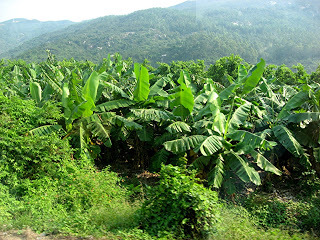 Banana trees (public domain)
Banana trees (public domain)But that was not all. Far from being in an area of wild, uncharted jungle in peril from attacks by Motilone Indians at the time when the photograph was taken as claimed by de Loys, he and his party were actually in an oil exploration camp very close to civilisation. Furthermore, there was vital, conclusive proof of this statement contained in the uncropped version of the Ameranthropoides photograph, yet which had been overlooked by everyone for decades, even after Tejera's earth-shattering announcement in front of a shocked and stunned Montandon back in 1929.
The proof was the presence in this picture of a banana crop on the opposite side of the river from where the dead spider monkey was propped up and photographed. Banana trees are of Asian and Australasian origin, they are not native to the New World, having been introduced there by humans, and they can only grow near civilisation, not in the wild jungle region of South America where de Loys had averred that the photograph had been snapped. So the presence of banana trees in that picture verified that it had been snapped in the former location, not in the latter one that de Loys had alleged. This in turn also negates a claim made by him that whilst supposedly in the remote jungle, no fewer than 17 of his men had died due to the inhospitable conditions and the hostile Motilone Indians (in reality, there is no independent confirmation of this). In addition, Tejera revealed that rather than de Loys having led a single 4-year expedition to the Tarra River region as so frequently claimed in subsequent accounts of the Ameranthropoides case, he had instead led several much shorter ones (Tejera even provided their respective specific dates), and rarely beyond the perimeter of civilisation, as demonstrated, for instance, by the presence of banana trees in the Ameranthropoides photo.
Having said that, the portion of the photograph showing these trees is sufficiently blurred for their conclusive identification to be somewhat tricky. Tejera was there when the photo was taken, so obviously he could clearly discern their true nature, but the evidence for them from the photo alone is less certain. Happily, however, there is one additional aspect of this image that vindicates his statement. In the lower right quadrant of the photo, alongside the monkey in the foreground, a leafy shoot is present that is identifiable as a chopped-down but now-regenerating banana tree (I have shown this to various friends who have kept banana trees, and they have all affirmed that this shoot is indeed one). I have arrowed it in the uncropped photo reproduced below.
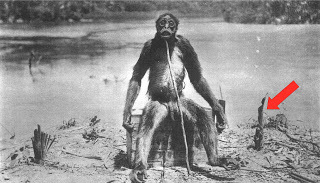 De Loys's full, uncropped Ameranthropoides photograph with the banana tree shoot in the foreground arrowed (public domain)
De Loys's full, uncropped Ameranthropoides photograph with the banana tree shoot in the foreground arrowed (public domain)In addition, an aspect that, very surprisingly, seems not to have been considered previously is that for a creature supposedly killed by a hail of bullets, it seems in the photograph to be remarkably free of bullet holes or wounds, especially as it was supposedly shot from the front, not from the back or side. This of course is readily explained by the fact that, thanks to Tejera, we now know that the creature wasn't an attacking ape that had been shot, it was merely a pet monkey that had died of natural causes.
Equally, as the photographed 'ape' specimen was merely a marimonda spider monkey after all, de Loys's allegation that its dentition was different from that of spider monkeys was clearly yet another falsehood. And no doubt his so-convenient explanation of why the skull had not been retained for formal scientific examination (he claimed that the camp cook had converted it into a salt container and that it had then fallen apart), which of course would have readily identified its true taxonomic nature and exposed his dentition claim as false, was also a blatant lie. Little wonder, then, why de Loys was not able to escape from the web of deceit that he had spun when carrying out his joke, and which had ultimately and inextricably enveloped him.
But that was still not everything. At least two years before penning to El Universal his devastating letter outing and condemning Montandon and the entire Ameranthropoides charade, Tejera had actually revealed all of this to fellow medical practitioner Dr Raymond Fiasson, who had documented it in his book Des Indiens et des Mouches: Dans les Llanos du Vénézuela(1960). Yet this too had escaped attention from cryptozoologists and zoologists alike. So also had a section included by American primatologist Prof. Earnest Hooton in his book Man's Poor Relations (1946) – a significant but hitherto-overlooked snippet until Michel Raynal had rediscovered it in 2007. Prof. Hooter had revealed that in late 1932, American geologist A. James Durlacher had written to him announcing that in 1927 he had spoken to various former members of de Loys's expeditions and had learnt from them that Ameranthropoideshad indeed merely been a marimonda spider monkey. Even more frustrating, in 2001 Spanish researchers Bernardo Urbani, Dr Ángel L. Viloria, and Franco Urbani had presented much of this key information in a paper published by the Spanish journal Anartia, Publicaciones Ocasionales del Museo de Biologia de La Universidad del Zulia, in which they had concluded that the Ameranthropoides saga was certainly a hoax – but yet again, this revelation had somehow evaded widespread attention! (It is even possible that Tejera's dramatic intervention at the end of Montandon's lecture back in 1929 was subsequently documented in some French newspaper(s) and/or periodical(s), but if so these too failed to attract any public notice and still await rediscovery.)
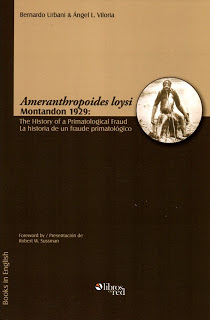 The revelatory book by Bernardo Urbani and Dr Ángel L. Viloria – Ameranthropoides loysi Montandon 1929: The History of a Primatological Fraud (© Bernardo Urbani and Dr Ángel L. Viloria/Editorial LibrosEnRed – reproduced here on a strictly educational, non-commercial Fair Use basis only)
The revelatory book by Bernardo Urbani and Dr Ángel L. Viloria – Ameranthropoides loysi Montandon 1929: The History of a Primatological Fraud (© Bernardo Urbani and Dr Ángel L. Viloria/Editorial LibrosEnRed – reproduced here on a strictly educational, non-commercial Fair Use basis only)Happily, however, their skilful detective work uncovering this hoax was at last given its long-deserved international attention when, in 2008, Bernardo Urbani and Dr Viloriapublished all of their findings in book form – Ameranthropoides loysi Montandon 1929: The History of a Primatological Fraud. The book's text was presented in two separate languages, English and Spanish, and was fully referenced, thus constituting the most comprehensive, and now-definitive, study and exposé of the whole sorry Ameranthropoides saga.
One final point to consider here, which I haven't seen mentioned before but which has intrigued me for some time, is whether de Loys was at least partly inspired when setting up his hoax photo by a very distinctive illustration that was still famous back then, although much less so today.
In 1758, eminent English naturalist and wildlife painter George Edwards wrote and illustrated Gleanings of Natural History, an authoritative tome that would remain a major work on that subject for well over a century. One of its illustrations was a hand-coloured copper engraving by Edwards of a young orang utan, among the first pictures ever prepared of this great ape, in which the orang utan was portrayed sitting upright on a wooden bench holding a long tall wooden stick in one hand. If this illustration is compared with the iconic Ameranthropoidesphoto, a number of striking similarities can be seen, including the orientation and/or form of the feet, limbs, facial expression, and even the stick (albeit utilised for different purposes).
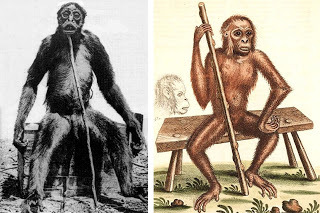 Comparison of the Ameranthropoides loysi photograph with the George Edwards illustration of an orang utan (public domain)
Comparison of the Ameranthropoides loysi photograph with the George Edwards illustration of an orang utan (public domain)Consequently, as Gleanings of Natural History was still well known during the early 20thCentury, it is not beyond the realms of possibility that de Loys had seen Edwards's orang utan illustration in it and had elected to reconstruct it using the dead spider monkey, but for practical purposes had transformed the stick into a supporting prop in his photo.
Ameranthropoides loysiRIP...? Although this specific case was a fraud from beginning to end, it should be noted that mystery animal researchers are well aware that large ape-like creatures, walking bipedally and lacking tails, have been frequently reported by natives and Western explorers alike from many parts of Central and South America, where they are referred to locally and variously by such names as the sisimite (in Belize), xipe (Nicaragua), shiru (Colombia), vasitri (Venezuela), didi (Guyana), tarma (Peru), mono rey (Bolivia), caipora and curupira (Brazil), and others too. Detailed documentation of such sightings lies outside the scope of this present article, but one extremely noteworthy, representative encounter occurred as recently as 1987, so is deserving of inclusion here.
That was when New York Botanical Gardens mycologist Gary Samuels was crouching down on the forest floor in Guyana, investigating fungi. Looking up, he was very startled to see a 5-ft-tall hairy ape-man, walking by at close range on its hind legs but seemingly unaware of him as he stayed kneeling, concealed on the ground. This remarkable entity, which uttered an occasional "hoo" cry as it passed by him, was presumably a didi.
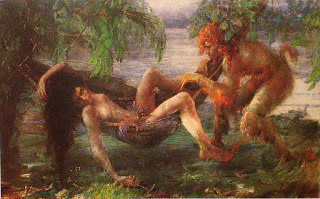 O Curupira
, by Brazilian painter Manoel Santiago, produced in 1926 and depicting the mythical(?) red-haired man-beast of Brazil known as the curupira (Wikipedia
CC BY 4.0 licence
)
O Curupira
, by Brazilian painter Manoel Santiago, produced in 1926 and depicting the mythical(?) red-haired man-beast of Brazil known as the curupira (Wikipedia
CC BY 4.0 licence
)Explorer Simon Chapman's book, The Monster of the Madidi: Searching For the Giant Ape of the Bolivian Jungle (2001), documented his search in Bolivia's Madidi region for the mono rey. Although he failed to find it, his book does contain a couple of tantalising snippets that were new to me. One was his claim that until recently, a local Bolivian actually owned a pelt from a mono rey, which was then purchased by "a gringo" (European) who took it home and sent it (or samples from it) off for DNA analysis, but the results (if any) were never revealed. No details were given in his book as to who the "gringo" was, where he came from, or where he sent the pelt/samples. The other snippet, which Chapman had apparently attempted unsuccessfully to substantiate, was that a living mono rey had allegedly once been exhibited at Bolivia's Santa Cruz Zoo! (This zoo is known in full as the Santa Cruz de la Sierra Municipal Zoo to distinguish it from others.)
Also worthy of note here is the existence of centuries-old carvings and statues depicting large, tailless, ape-like beasts, found among the crumbling relics from long-gone civilisations in various South American (and also Mexican) localities. Just coincidence – or representations of genuine creatures? There is even an unequivocally ape-like mask preserved at Chicago's Field Museum of Natural History, which had been carved in stone by Costa Rica's Guetar Indians and dates from 1200 to 1500 AD.
At one time, a major zoological stumbling block to accepting the possibility that any such entities actually do exist today in Latin America was the absence of fossil precedents. That all changed in 1995, however, with the publication of a paper by American anthropologist Dr Walter Hartwig in the Journal of Human Evolution, which documented the remains of a very sizeable Pleistocene monkey discovered in the Lagoa Santa cave system of Minas Gerais in southeastern Brazil. In fact, this large-bodied species had originally been described as long ago as 1838, by Danish naturalist Peter Wilhelm Lund, who had named the extinct species Protopithecus brasiliensis. However, later publications concerning it had not examined the original fossils and had underestimated this species' actual size. In his paper, however, Hartwig rectified that error, and estimated that P. brasiliensis may well have been more than twice as massive as any living New World monkey.
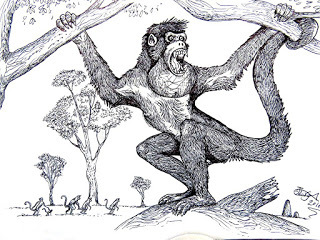 Reconstruction of Cartelles coimbrafilhoi(© Hodari Nundu)
Reconstruction of Cartelles coimbrafilhoi(© Hodari Nundu)Just a year later, on 23 May 1996, Hartwig published a second Protopithecuspaper, this time in Nature and co-authored with Brazilian palaeontologist Dr Castor Cartelle. In it, they described a near-complete skeleton, which had been found in 1992 within Pleistocene cave deposits in Brazil's 60-mile-long Toca da Boa Vista, the longest cave in the Southern Hemisphere, located in the Brazilian state of Bahia. Intriguingly, this skeleton combined a howler monkey-like vocal sac with a spider monkey-like cranium, and sported a robust body with limbs adapted for brachiation (arm-swinging locomotion), similar to both spider monkeys and woolly monkeys (and also Old World gibbons).
The giant species represented by it, which would have weighed around 50 lb, is now housed within the spider monkey subfamily, Atelinae. Moreover, after detailed studies it was considered sufficiently distinct from the earlier Protopithecusmaterial to warrant its reclassification as a new species (and genus) in its own right, which in 2013 was formally christened Cartelles coimbrafilhoiin a Journal of Human Evolution paper written by Drs Lauren B. Halenar and Alfred L. Rosenberger.
Also found in that same cave and at the same time was a near-complete skeleton of another, hitherto-unknown, species of giant Pleistocene ateline monkey. In a Proceedings of the National Academy of Science, USA paper published on 25 June 1996, this new species was duly christened Caipora bambuiorum (after the caipora, a small, peccary-riding humanoid entity in Brazilian Tupi-Guarani mythology), and would have weighed around 45 lb in life. And in 2000, after co-leading a palaeontological expedition to Toca de Boa Vista, Hartwig announced that thousands of fossils, mostly from extinct mammals, had been unearthed there – including the skull of a 55-lb giant spider monkey, over twice the size of any species alive today.
 Artistic representation of a caipora riding a peccary (© Jakared/Wikipedia
CC BY-SA 3.0 licence
)
Artistic representation of a caipora riding a peccary (© Jakared/Wikipedia
CC BY-SA 3.0 licence
)So perhaps it is premature after all to dismiss entirely the prospect that the Neotropical (platyrrhine) primate lineage may indeed have evolved a larger, ape-like representative via convergent evolution, one that occupies some of the ecological niches filled in the Old World by the apes, and which still awaits formal zoological discovery and recognition.
A very exciting possibility if true, that's for sure!
Further information concerning the history of Ameranthropoides loysi (including evidence supporting the intriguing prospect that some additional photographs taken by de Loys of his spider monkey in Ameranthropoides pose may also exist) can be found in my book Extraordinary Animals Revisited . It also features on its front cover a colourised version of de Loys's notorious yet never-to-be-forgotten South American 'ape' photograph – truly a cryptozoological icon, albeit for all the wrong reasons.

Published on July 30, 2017 16:24
July 29, 2017
A PICTURE OF MONKEY BUSINESS - OR, HOW A SMALL FURRY PET BECAME A GIANT MYSTERY APE. PART 1: THE 'OFFICIAL' HISTORY OF AMERANTHROPOIDES LOYSI
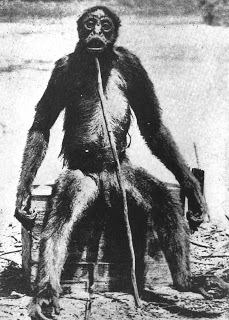 Cropped version of Dr François de Loys's photograph of the supposed South American ape Ameranthropoides loysi – one of the most controversial cryptozoological images of all time (public domain)
Cropped version of Dr François de Loys's photograph of the supposed South American ape Ameranthropoides loysi – one of the most controversial cryptozoological images of all time (public domain)There will never be a more appropriate time than right now to document the following case here on ShukerNature, because this year, 2017, is its centennial – the hundredth anniversary of one of the most contentious zoological events in modern times. Namely, the alleged discovery of a hitherto-unrecognised species of ape in South America - a continent not known to possess any ape forms. This enigmatic episode thereafter remained a unique controversy in the annals of zoology for many decades before finally being resolved only in recent years. I have not previously documented on ShukerNature what became known as Ameranthropoides loysi, Loys's South American ape, so here's my take on it.
But let us begin at the very beginning of this truly exceptional case, by first of all presenting herewith its 'official' version of events, which was faithfully reiterated time and time again by cryptozoological chroniclers and commentators for many decades before the true but very different version eventually emerged.
From 1917 to 1920, Swiss geologist Dr François de Loys (1892-1935) and a team of colleagues had supposedly been conducting a scientific expedition through a little-explored forest-covered range of mountains called the Sierra de Perijá, straddling the border between Venezuela's Zulia State and Colombia's Cesar Department. It was said to be a forbidding, inhospitable region, with the hapless party reputedly beset by virulent tropical diseases, threatened by all manner of venomous fauna, and perpetually in fear of the hostile Motilone Indians with their deadly poison-tipped arrows.
 Dr François de Loys (public domain)
Dr François de Loys (public domain)Yet even when de Loys and his party returned to civilisation in 1920, however, their ordeal was far from over. Before the close of the 1920s, the expedition, and de Loys in particular, would be accused by many of perpetrating a deliberate, elaborate hoax - and all because of one very remarkable photograph.
According to an article written by de Loys that was published on 15 June 1929 by the Illustrated London News, in an unspecified year (but later revealed to have been 1917) his party had been exploring previously untrodden forests along the Tarra River, a tributary of the Rio Catatumbo, in southwestern Lake Maracaibo, Zulia State, Venezuela. Suddenly, near a bend in one of the Tarra's own, western tributaries, two strange creatures strode into view just ahead, resembling tall, hairy, tailless apes walking on their hind legs.
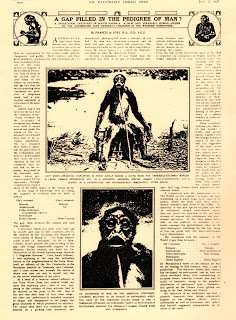 De Loys's Illustrated London News article for 15 June 1929 - click image to enlarge it for reading purposes (public domain)
De Loys's Illustrated London News article for 15 June 1929 - click image to enlarge it for reading purposes (public domain)Approaching the party, they became increasingly violent, screaming wildly and ripping branches and foliage off nearby vegetation in anger. As a further gesture of their barely contained fury, they even defaecated into their hands and threw their excrement at the explorers - who by then were not only astonished at the sight of such totally unfamiliar creatures, but were also thoroughly alarmed, fearing for their own safety. Consequently, when what seemed to be the male member of the pair, leading its mate towards them, drew even closer, de Loys and party opened fire at it with their guns. Just as they did so, however, the male moved to one side, in order for his mate to approach alongside him. As a result, he escaped the majority of the shots, which hit the female instead, killing her instantly - whereupon the male turned and fled.
The female's body was closely examined by the explorers, who were all completely mystified by its singular appearance. So, once back at camp, they sat the body upright on a packing case in their possession there, keeping it erect by propping it up with a long stick placed underneath its chin, then they measured it, and photographed it from the front (but seemingly not from the back - a critical component of this saga). According to de Loys, most of those b/w photographs were tragically lost a little later, when their boat capsized in a river, but one superb photograph was saved. This is reproduced here, not only in its well known background-cropped form that opens this present two-part ShukerNature article, but also in its less familiar uncropped form, reproduced below, because the latter version contains a key feature whose immense significance was entirely unnoticed by scientists for several decades (as will be revealed later in this article of mine).
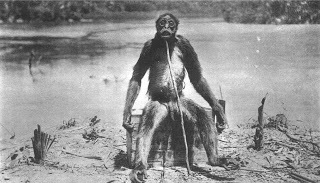 The uncropped version of Dr François de Loys's photograph of the supposed South American ape Ameranthropoides loysi (public domain)
The uncropped version of Dr François de Loys's photograph of the supposed South American ape Ameranthropoides loysi (public domain)The surviving photograph plus the measurements recorded by de Loys implied a truly extraordinary creature. Fundamentally, it was most similar to the Ateles spider monkeys, possessing a number of features characterising these familiar South American primates.
For example: each of its eyes was encircled by a prominent ridge of bone; its genital organs were very large; its thumbs were extremely small; its hands and feet were shaped like those of spider monkeys; the triangular patch of pale pigment on its forehead compared closely with that of the long-haired or white-bellied spider monkey Ateles belzebuth (a species itself known from the Rio Tarra valley, and referred to locally as the marimonda); and, like all New World primates, not just spider monkeys, its nostrils opened sideways and were separated from one another by a thick division of cartilage (the platyrrhine- 'flat-nosed' - condition). Also, its clitoris was very large, yet another spider monkey characteristic, but one that has fooled quite a few people down through the years into mistakenly assuming that it was a male.
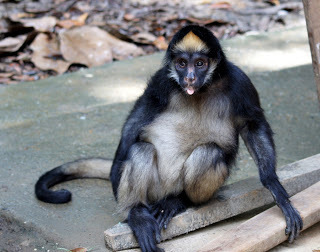 Marimonda spider monkey (© Ewa-Flickr/Wikipedia
CC BY 2.0 licence
)
Marimonda spider monkey (© Ewa-Flickr/Wikipedia
CC BY 2.0 licence
)Yet in stark contrast to spider monkeys, the largest of which never attain a total height much in excess of 3.5 ft, de Loys's paradoxical primate allegedly measured a mighty 5 ft 1.75 in - equalling all but the loftiest of chimpanzees. Also, its limbs appeared sturdier than those of spider monkeys - species specifically famed, and named, for their limbs' noticeably gracile, arachnine appearance. Similarly, its body seemed stockier, with broader shoulders. In his classic book On the Track of Unknown Animals (1958), veteran cryptozoologist Dr Bernard Heuvelmans opined that its thorax also seemed longer and flatter, more like that of an Old World ape than like that of a New World spider monkey. Most significant of all: according to de Loys's testimony, it was tailless (unlike any known species of South American primate), and only possessed 32 teeth (all known South American primates have 36, occasionally more).
Following his return to Europe, de Loys consulted Swiss-born French zoologist Prof. George Montandon, and provided him with much information concerning his party's baffling discovery, plus the precious photograph, but was unable to offer any physical remains - although this is not as surprising as it may initially seem. After all, the appalling conditions that the expedition had supposedly faced during its jungle forays had been more than enough to deal with, surely, without the additional problems that would have been posed by attempting to transport a hulking 5 ft carcase all too soon to transform into a stinking mass of putrefaction. Allegedly, they did salvage the skull, but their party's cook ill-advisedly used it as a salt container. As a result it had completely disintegrated before their departure for Europe. (And a comparably regrettable fate reputedly befell the specimen's skin of greyish-brown fur too.)
 Prof. George Montandon (public domain)
Prof. George Montandon (public domain)Nevertheless, de Loys's testimony and the striking photograph sufficiently convinced Montandon that the creature had been something totally new and significant for him to publish a formal paper in the renowned French scientific journal Comptes Rendus de l'Académie des Sciences on 11 March 1929, introducing it to the scientific world. Moreover, so certain was Montandon that it represented a South American counterpart to the Old World apes, i.e. a New World species of comparable evolutionary status to the gibbons, gorillas, orang utans, and chimpanzees, that he named its species Ameranthropoides loysi - 'Loys's American ape'. Thus ends the 'official' version of events surrounding the discovery and scientific description of this anomalous entity (as will be seen later, however, the real, true version turned out to be very different indeed...).
Scientists throughout the world were astounded - the concept of a New World ape seemed so alien to zoological tradition (in which apes were strictly confined to the Old World) that most found it impossible to accept. So it was not long before a variety of published opposition to Montandon's views materialised. Among these was the uncompromising contribution by British primatologist Sir Arthur Keith, who sternly pronounced in August 1929 within the periodical Man that Ameranthropoides was nothing more than an ordinary spider monkey (he personally favoured Ateles paniscus, the black spider monkey). Keith was particularly sceptical about its alleged absence of tail, great size, and depauperate dentition. Consequently, he felt that at most it should merely have been named Ateles loysi, thereby allying it with the spider monkeys, and flatly rejecting Montandon's views that it was the Americas' answer to an ape.
 Sir Arthur Keith (Wikipedia
CC BY 4.0 licence
)
Sir Arthur Keith (Wikipedia
CC BY 4.0 licence
)Similar and sometimes even stronger views were expressed by many other zoologists too. One aspect that again attracted much adverse criticism and suspicion was the supposed taillessness of de Loys's 'ape'. Some authorities clearly felt that it appeared tailless in the photograph only because its tail had been deliberately cut off, or hidden from view. Certain others, like Francis Ashley-Montague, writing in Scientific Monthly in September 1929, seemed willing to accept that its taillessness was genuine, but suggested that this may not have been a natural feature. Instead, it could have resulted from an accident at early infancy (adult male monkeys have often been known to bite off the tails of their offspring).
Also engendering much heated discussion and dissension was the creature's impressive height. Once again, some suspected a hoax. And certainly, Montandon noticeably changed his mind several times between various publications before finally claiming that the standard size for petrol crates of the type supporting its body in the photograph was 18 in. If true, this would provide a standard measurement that could be used to estimate accurately the creature's total height from the photograph alone (i.e. independent of de Loys's measurements taken directly from the creature itself).
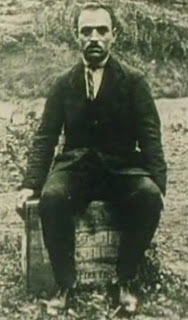 Montandon's assistant sitting on what Montandon claimed to be a similar type of crate to the one in the Ameranthropoides photo – but was it? (public domain)
Montandon's assistant sitting on what Montandon claimed to be a similar type of crate to the one in the Ameranthropoides photo – but was it? (public domain)Using this method and Montandon's claimed dimension for the crate, a total height of 5 ft was obtained for the creature, which agreed very closely with de Loys's statement. To emphasise further the notable size of Ameranthropoides, and using what he claimed to be equivalent crates to the example in de Loys's picture, Montandon even published a series of comparative photographs that showed a man (his assistant) and a spider monkey sitting on the crates in the same pose as that of Ameranthropoides in the original photo. His critics, however, remained unconvinced - and ultimately they won the day.
In 1930, as a final attempt to silence and satisfy his opponents, Montandon's full scientific treatment of the ambiguous Ameranthropoides was published, in the journal Archivio Zoologico Italiano, complete with a formidable list of pertinent references. It certainly silenced them, after a fashion - because it attracted no response at all. Instead, Ameranthropoides was summarily dismissed as at best a monster of misidentification, based upon a specimen of the marimonda (which is the most robust species of spider monkey), or at worst as assuredly a fraud (even though no actual evidence for this proposal had been offered up for examination at that time).
 Ivan T. Sanderson's classic book Abominable Snowmen: Legend Come To Life (© Chilton Book Company, Philadelphia – reproduced here on a strictly educational, non-commercial Fair Use basis only)
Ivan T. Sanderson's classic book Abominable Snowmen: Legend Come To Life (© Chilton Book Company, Philadelphia – reproduced here on a strictly educational, non-commercial Fair Use basis only)In the opinion of renowned American cryptozoologist Ivan T. Sanderson (who was also, like Heuvelmans, a qualified zoologist), which he outlined tersely in his book Abominable Snowmen: Legend Come To Life (1961), the creature's very burly form was not the product of anatomical design at all. Instead, this was the outcome of advanced decomposition inside its carcase - which had correspondingly swollen or 'blown' to yield a bloated body that would bear little resemblance to its form in the living state. Sanderson did not believe that it was naturally tailless either, and he revealed that the type of petrol crate upon which it had been sat propped up and then photographed was not 18 in high, but only 15.5 in, thereby decreasing the creature's estimated height to within the marimonda spider monkey's range.
Primate researcher Don Cousins also questioned the crate's size, and in an April 1982 article published by the British monthly magazine Wildlife he too selected the marimonda as the likeliest identity for Ameranthropoides. Indeed, he even included a photograph of one that had been killed in the Tarra River region by American engineer/geologist A. James Durlacher while working there with the Shell Oil Company in 1927, and had then been posed in an upright sitting position to be photographed. Had its long tail not been readily visible, one might well be forgiven for assuming that this creature was a second Ameranthropoidesspecimen, so similar to the latter does it look, as seen here in Durlacher's 1936-published photo of it. (Incidentally, please keep Durlacher in mind, because he reappears in a very significant manner within Part 2 of this ShukerNature article.)
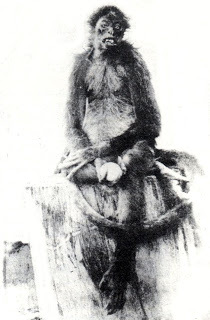 A. James Durlacher's 1936-published photograph of the dead marimonda spider monkey, posed in an upright sitting position (public domain)
A. James Durlacher's 1936-published photograph of the dead marimonda spider monkey, posed in an upright sitting position (public domain)Even so, as recently as 1981 Heuvelmans did not agree with Sanderson concerning this subject, still favouring instead the absolute authenticity of Ameranthropoides, as revealed in the following never-before-published passage excerpted from a letter concerning several different cryptids that Heuvelmans had written on 30 November of that year to English cryptozoological enthusiast Michael Playfair:
LOYS' [sic] APE; All I can is that Ivan is wrong. The calculations by M. Cintract are undoubtedly accurate. Loys' [sic] ape is possibly not an unknown ape, but certainly a gigantic spider monkey, possibly an over-sized specimen, but much more probably a representative of an unknown species.
Mr Cintract was a photographer whose attempts to calculate the likely height of the Ameranthropoidesspecimen, which he ultimately estimated to be between 5 ft and 5 ft 3 in, were cited by Montandon in his Comptes Rendus paper of 11 March 1929.
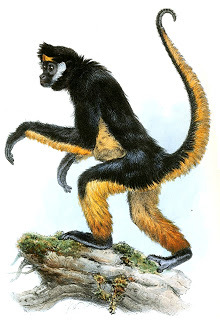 Painting from 1867 of a marimonda spider monkey, seen from the side and therefore readily revealing its long tail (public domain)
Painting from 1867 of a marimonda spider monkey, seen from the side and therefore readily revealing its long tail (public domain)Conversely, in subsequent years a very sinister, previously-unpublicised ulterior motive for Montandon's desire to acquire scientific recognition for Ameranthropoidesas a bona fide South American ape came to light, courtesy of research by American cryptozoologist Loren Coleman and French cryptozoologist Michel Raynal. In a revelatory article, published by The Anomalist in autumn 1996, they brought to attention that Montandon had proposed and actively promoted an extreme, racist theory of human evolution called hologenesis.
Put simply, this theory claimed that instead of the modern-day multi-racial human species Homo sapiens having arisen from a single common ancestor, its various races had sprung up simultaneously but independently of one another, and with non-white races having evolved according to Montandon from various different species of ape.
 Front cover of The Anomalist #4, containing the Coleman-Raynal paper concerning Montandon and the Ameranthropoides photograph (© The Anomalist)
Front cover of The Anomalist #4, containing the Coleman-Raynal paper concerning Montandon and the Ameranthropoides photograph (© The Anomalist)For example, Montandon believed that Africa's black nations had arisen from the gorilla, whereas Asia's oriental nations had arisen from the orang utan. However, a major flaw for him was that he could offer no suitable ape ancestor for the Native American nations – until, that is, Ameranthropoides had come along. Suddenly, Montandon had been presented with an opportunity to plug what for him had hitherto been a gaping hole in his hologenesis theory, thus explaining why he was so insistent in supporting the claim of Ameranthropoides as a legitimate ape rather than a mere monkey (and also why he had therefore increased his claim regarding the crate's dimensions – namely, to ensure that Ameranthropoideswas physically big enough to be accommodated within his hologenesis theory).
Towards the end of World War II, however, Montandon was apparently shot by the French as a traitor, and, with him, his objectionable, ludicrous theory of hologenesis died too. The controversy regarding the zoological identity of Ameranthropoides, conversely, persisted – until 2007, when Michel Raynal made a remarkable announcement on the website Cryptomundo. Namely, he had discovered to his amazement that the true nature of Ameranthropoides – that in reality it was a blatant, deliberate hoax – had actually been made public as far back as the early 1960s. Moreover, it had been publicly reiterated three decades later too - but, incredibly, none of these crucial revelations had previously attracted any attention from either the cryptozoological community or the mainstream zoological world!
In Part 2 of this ShukerNature article, I shall be unfurling the vital yet long-overlooked information that unequivocally exposed the entire Ameranthropoidesepisode as a blatant, deliberate hoax. Don't miss it!
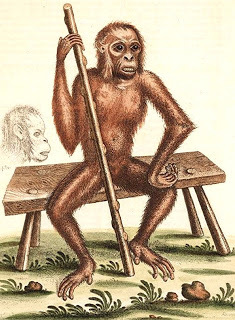 Having read the above article concerning Ameranthropoides loysi and viewed its iconic photograph snapped in 1917, does this intriguing illustration from 1758 look in any way familiar to you...? (public domain) – Find out more in Part 2, coming very soon here on ShukerNature!
Having read the above article concerning Ameranthropoides loysi and viewed its iconic photograph snapped in 1917, does this intriguing illustration from 1758 look in any way familiar to you...? (public domain) – Find out more in Part 2, coming very soon here on ShukerNature!
Published on July 29, 2017 18:14
July 28, 2017
HOW A GIANT SNAKE BECAME A SPIKY SEASHELL – WELCOME TO THE MAUSOLEUM OF MONSTERS
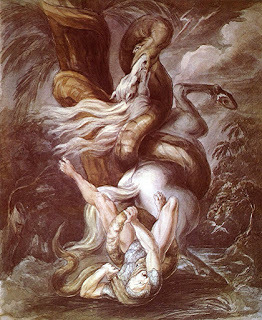 One of several artworks by Swiss painter Henry Fuseli (1741-1825) with a cryptozoological connection – Reiter Von Riesenschlange Überfallen ('Horseman Attacked By A Giant Snake'); watercolour, painted in c.1800 (public domain)
One of several artworks by Swiss painter Henry Fuseli (1741-1825) with a cryptozoological connection – Reiter Von Riesenschlange Überfallen ('Horseman Attacked By A Giant Snake'); watercolour, painted in c.1800 (public domain)In contrast to insidious and infamous zoological frauds such as Piltdown Man and the stuffed mermaids of Oriental origin, many cases of confused taxonomic classification have occurred not through deliberate, predetermined intentions to create non-existent creatures or to lure scientists along false trails, but instead via simple misidentifications. Nonetheless, the results have often been both unexpected and spectacular, but few more so than in the case of the giant venomous serpent of South America's Gran Chaco region. After all, how can such an ostensibly monstrous reptile transform into a spiky seashell of far more modest proportions and far less dangerous attributes?
As I now reveal here in ShukerNature, the story of this astonishing metamorphosis, though largely forgotten today, must surely rate as one of the most extraordinary (and embarrassing) incidents in the entire history of 20th-Century zoology.
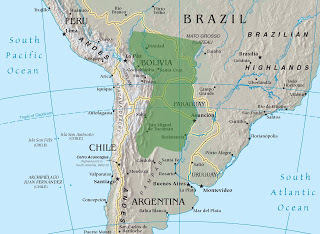 Gran Chaco location on map (public domain)
Gran Chaco location on map (public domain)Deep within the most secluded realms of the mystery beast investigator's mind lies a dark and mournful cemetery, whose gates are for the most part firmly chained and heavily barred. Whenever his speculations and theories aspire to the grandiose and gothic, however, he is forced to tread the shadowy pathway leading to this most dreaded and dreadful of destinations - the mausoleum of monsters.
In this forsaken spot – within this cryptic catacomb of mythological mammalia, apocalyptic archosauria, and other fabulous fauna of every type - no ordinary assemblage of skeletons is ensconced. No, indeed. Here, amongst shattered dreams and mocking illusions, lie the hastily-jettisoned remains of those great zoological discoveries that were subsequently exposed as sorry misidentifications. A faux-pas phantasmagoria, whose forbidding presence within the annals of zoology serves as a stern warning to all cryptozoologists of the perils of premature pronouncement or imprudent identification. Let us tarry a while here, and examine one of its most dramatic examples.
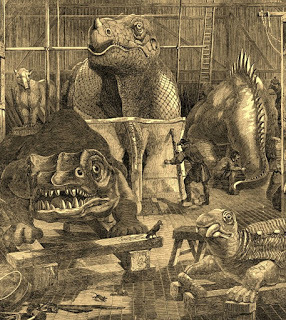 A veritable mausoleum of monsters – an exquisite 19th-Century engraving depicting some of the Victorian-age prehistoric animal sculptures of Crystal Palace created by English sculptor Benjamin Waterhouse Hawkins (1807-1894) (public domain)
A veritable mausoleum of monsters – an exquisite 19th-Century engraving depicting some of the Victorian-age prehistoric animal sculptures of Crystal Palace created by English sculptor Benjamin Waterhouse Hawkins (1807-1894) (public domain)In 1926, the Proceedings of the Royal Society of Edinburgh published a paper by Prof. Sir John Graham Kerr, at that time Regius Professor of Zoology at the University of Glasgow, in which he described a huge, curved poison fang belonging to a hitherto unknown genus and species of giant snake - which he formally named Bothrodon pridii (with Bothrodon translating as 'furrow-tooth').
Approximately 2.5 in long as measured along the outside of the curve, this fang was truly enormous.
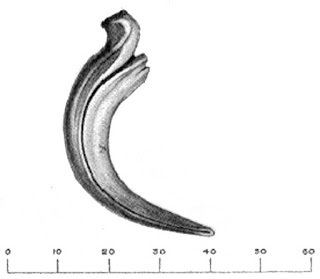 Bothrodon pridii
'fang', pictured in 1926; scale in mm (public domain)
Bothrodon pridii
'fang', pictured in 1926; scale in mm (public domain)Indeed, as noted by now-retired mollusc expert David Heppell from the Royal Museum of Scotland who documented this specimen in The Conchologist's Newsletter (March 1966), it was roughly nine times longer than that of a 6-ft-long boomslang Dispholidus typus - one of the world's deadliest snakes.
Moreover, it even dwarfed the fangs of the Gaboon viper Bitis gabonica. Native to much of sub-Saharan Africa, this formidable serpent not only is the largest member of the genus Bitis and the world's heaviest species of any type of viperid, but also holds the record for the longest fangs of any known species of snake alive today – up to 2 in long.
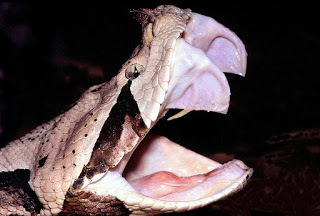 Gaboon viper showing its huge fangs (© Brimac the 2nd/Wikipedia
CC BY 2.0 licence
)
Gaboon viper showing its huge fangs (© Brimac the 2nd/Wikipedia
CC BY 2.0 licence
)Accordingly, judging from the relative size of the fang, Prof. Kerr estimated that the total length of its venomous owner, Bothrodon pridii, could have approached 60 ft or so.
Truly a monster, in every sense of the word!
 Prof. Sir John Graham Kerr (© T & R Annan & Sons Ltd/Wikipedia
CC BY 4.0 licence
)
Prof. Sir John Graham Kerr (© T & R Annan & Sons Ltd/Wikipedia
CC BY 4.0 licence
)The poison fang had been obtained by one of Kerr's friends, missionary Andrew Pride (after whom Kerr had named this outsized ophidian) from the Gran Chaco's silt-like deposits, which dated back no further than the Pleistocene epoch (2.5 million to 11,700 years ago). Despite a prolonged, thorough search of this locality by Pride for this mega-snake's skeletal remains, however, none were found.
In his paper Kerr concisely described the fang's appearance, including the prominent poison groove running all along its apparent external face, as well as the two narrow parallel stripes, dark-brown in colour, that lay along the distal (terminal) portion of its length. He also discussed the possible phylogenetic relationships of Bothrodon pridii itself, by comparing its fang's morphology with that of contemporary snake species.
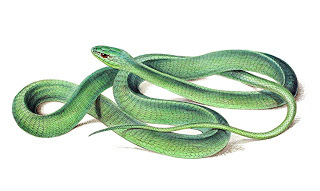 The boomslang, an opisthoglyphan snake, depicted in 1838 (public domain)
The boomslang, an opisthoglyphan snake, depicted in 1838 (public domain)From these studies, Kerr concluded that the fang most closely resembled those of the opisthoglyphans. This is a group of rear-fanged colubrid snakes that include the boomslang, and which point the way towards the more highly-evolved present-day venomous snakes. In addition, Kerr deduced from the fang's peculiar hook-like shape that, rather than functioning as a striking fang, it most probably served to hold the prey stationary whilst its poison entered the wounds produced by the snake's other teeth in the prey's flesh.
Sherlock Holmes would certainly have approved - because Kerr's paper demonstrated most effectively the considerable amount of information concerning an entire organism (be it serpent or sapient!) that could be obtained by meticulous analysis of only a single component of that organism. Or so it seemed...
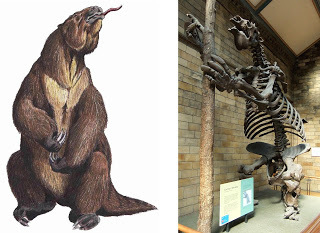 Reconstruction of the giant ground sloth Megatherium (public domain) alongside a fossil skeleton of it at London's Natural History Museum (© Dr Karl Shuker)
Reconstruction of the giant ground sloth Megatherium (public domain) alongside a fossil skeleton of it at London's Natural History Museum (© Dr Karl Shuker)Kerr duly presented this unique fang to the Hunterian Museum of the University of Glasgow, and in 1933 a cast of it was displayed alongside a label stating that Bothrodonmay have fed upon cumbersome plains-dwelling creatures such as the giant ground sloth Megatherium.
Conversely, noted herpetologist Dr Raymond Ditmars suggested small mammals as likely prey in his classic book Snakes of the World (1931).
 Dr Raymond Ditmars (public domain)
Dr Raymond Ditmars (public domain)Nevertheless, Ditmars was palpably impressed by Kerr's discovery and documentation of Bothrodon, exclaiming in his snake book:
It was during the preparation of this manuscript that the author received the greatest surprise in the many years he has studied the serpent clan – and it related to a rear-fanged snake.
Its possible stature also greatly excited Ditmars:
As the poison-conducting teeth of the rear-fanged snakes are short in proportion to the body length, the size of this monster is open to thrilling conjecture...Indeed the thought it inspires rather dulls the conjectural image of that dinosaurian star, Tyrannosaurus, whose races passed away ages before this mammoth Bothrodon prowled the soil.
I'm not quite sure how a limbless creature can be said to prowl; but in any event, as a serpent of substance Bothrodon remained unchallenged – until 1939, that is, when it was unceremoniously dethroned, disgraced, and, worst of all, exposed as nothing more than a snail in snake's similitude!
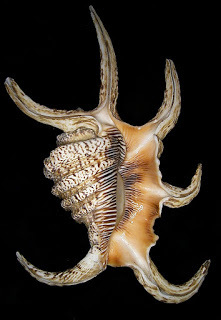 Chiragra spider conch's shell, underside (© Udo Schmidt/Wikipedia
CC BY-SA 2.0 licence
)
Chiragra spider conch's shell, underside (© Udo Schmidt/Wikipedia
CC BY-SA 2.0 licence
)For Dr W. Quenstedt, after closely examining a coloured cast of the fang sent to the University of Berlin's Paleontological Museum by Prof. Kerr, recognised the specimen's true identity. It was one of those six curved projections, long and groove-bearing, that fringe the large aperture of Lambis [now Harpago] chiragra, the Chiragra spider conch - a large and ornate, modern-day species of Indo-Pacific gastropod mollusc! Every feature of the 'fang' confirmed this identity – its size, shape, long groove, brown stripes. There could be no mistake – Bothrodon pridii was no more.
To be fair, however, Kerr's misidentification is not as surprising as it may seem on first sight. After all, he could hardly have been expected to anticipate the discovery within the deposits of Paraguay's Gran Chaco of a shell fragment from a gastropod normally inhabiting the Indo-Pacific oceans.
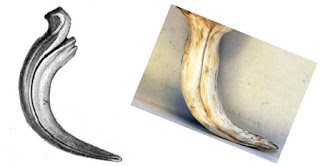 Bothrodon'fang' and shell projection from Chiragra spider conch's shell (public domain)
Bothrodon'fang' and shell projection from Chiragra spider conch's shell (public domain)Indeed, this one aspect of Bothrodon's bizarre history remains totally unexplained and seemingly inexplicable even today. How could a section of shell from a modern-day Indo-Pacific mollusc have been obtained in Gran Chaco? David Heppell noted that there is no question that Gran Chaco was the locality involved. Thus, as he remarked, the discovery can be explained only by way of some human introduction.
Notwithstanding this, the survival of Bothrodon pridii within the zoological literature on taxonomic synonyms serves as a stark reminder of just how easily and how far one can travel along the wrong track after having once set foot upon it. Certainly, although many weird metamorphoses have been documented from the animal kingdom, few can surely compare with the transformation of a giant snake into a spiky seashell!
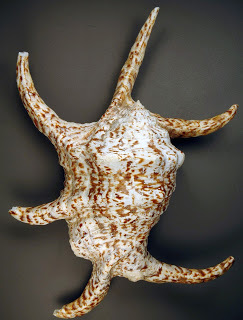 Chiragra spider conch's shell, upper side (© James St John/Wikipedia CC BY 2.0 licence)
Chiragra spider conch's shell, upper side (© James St John/Wikipedia CC BY 2.0 licence)As a curious footnote (assuming of course that anything concerning snakes can possess a foot!): even though the re-identification of the Bothrodon 'fang' as a prong from the shell of a Chiragra spider conch was swiftly and fully accepted by the herpetological community following Quenstedt's dramatic denouement in 1939, it is possible that Kerr himself was not so quick to accept this embarrassing revelation.
The reason why I suggest this is that while browsing very recently through Kerr's book A Naturalist in Gran Chaco, first published in 1950 and chronicling the zoological expedition that he mounted during the late 1890s to this vast semi-arid region of southern South America (overlapping northwestern Bolivia, western Paraguay, northern Argentina, and a small portion of southwestern Brazil), I was very surprised to find that although he included just over a page devoted to the Bothrodon specimen's discovery and his studies of it, he made no mention whatsoever of its molluscan re-identification. Equally, however, I can find no mention anywhere of his ever having publicly discounted or disputed this latter taxonomic reassignment of it.
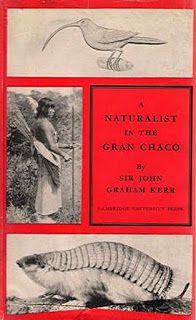 Hardback first edition of Sir John Graham Kerr's book A Naturalist in Gran Chaco(© Sir John Graham Kerr estate/Cambridge University Press – reproduced here on a strictly non-commercial Fair Use basis only, for educational/review purposes)
Hardback first edition of Sir John Graham Kerr's book A Naturalist in Gran Chaco(© Sir John Graham Kerr estate/Cambridge University Press – reproduced here on a strictly non-commercial Fair Use basis only, for educational/review purposes)So how can we explain this very curious, and conspicuous, absence in Kerr's book, which was first published more than a decade after Quenstedt's fateful, published declaration? As Kerr died just seven years later, in 1957, it is likely that we shall never be able to answer this highly intriguing question with any degree of certainty.
Taxonomically speaking, therefore, Bothrodon pridii may indeed be long dead and buried within the mausoleum of monsters, but perhaps its mystery is not entirely extinguished after all.
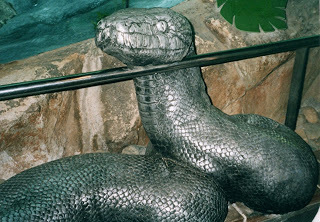 My own close encounter with a giant snake… - a magnificent life-sized sculpture by Tim Johnman of a reticulated python at Taronga Zoo in Sydney, Australia, which I visited in 2006 (© Dr Karl Shuker)
My own close encounter with a giant snake… - a magnificent life-sized sculpture by Tim Johnman of a reticulated python at Taronga Zoo in Sydney, Australia, which I visited in 2006 (© Dr Karl Shuker)
Published on July 28, 2017 11:27
July 16, 2017
IS NOSFERATU AN ILLUMINATED VAMPIRE?
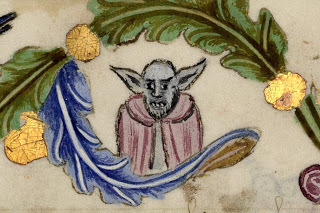 Is the devil – or vampire – in the detail? Close-up of the mysterious, sinister-looking entity lurking in the upper margin of folio 28v from the Sankt Florian Psalter (public domain)
Is the devil – or vampire – in the detail? Close-up of the mysterious, sinister-looking entity lurking in the upper margin of folio 28v from the Sankt Florian Psalter (public domain)Just in case you're wondering, the illuminated vampire under consideration here is definitely not one of the sparkling, shimmering, but invariably angst-ridden teenage variety that frequent a certain series of romance-driven novels (and accompanying films) for young adults. No indeed, this one is none other than Nosferatu himself, the dreaded Count Orlok of the long incisors and even longer ears, and this present ShukerNature blog article of mine records my unexpected discovery of him, or someone very much like him, in an exceedingly unlikely locality – a medieval illuminated manuscript!
ShukerNature readers may well recall that some time ago I documented an astonishingly Yoda-like entity existing far far away from his usual galactic Star Wars abode as a Jedi Knight – residing instead inside an early illuminated manuscript known as the Smithfield Decretals (click here to read my article), dating from c.1300-1340. Apparently, however, he wasn't the only fictitious figure to lurk undetected until recent times within the rarified illustrative realm of medieval marginalia, as now revealed.
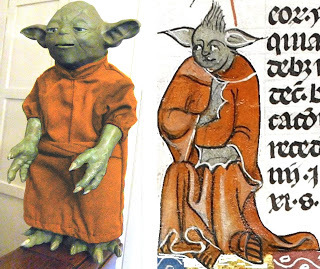 Comparison of my official Yoda model with the Yoda-like entity hidden away in the Smithfield Decretals (© Dr Karl Shuker/public domain)
Comparison of my official Yoda model with the Yoda-like entity hidden away in the Smithfield Decretals (© Dr Karl Shuker/public domain)As I noted when blogging previously about the presence of snail-cat illustrations in illuminated manuscripts (click here ), psalters were volumes of predominantly medieval age that normally contained the 150 psalms of the Old Testament and a liturgical calendar. They were also beautifully illustrated in illuminated form by monks.
One of the most ornate examples is the Sankt Florian Psalter, also known as the Saint Florian Psalter or the Psalterium Trilingue. It was written between the late 14th and early 15thCenturies, and its text is presented in three different languages – Latin, Polish, and German (the Polish version contains the earliest presentation of the psalms in Polish). It was first discovered in 1827, by local librarian Father Josef Chmel, at the St Florian monastery of Sankt Florian – the Austrian town after which this psalter is named – and is currently held as a priceless religious and iconographical treasure at the National Library of Poland, in Warsaw.
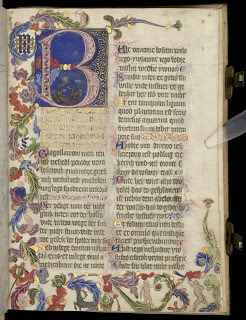 The beginning of Psalm 1, gorgeously illuminated in the margins with assorted plants, animals, human figures, and other adornments, from the Sankt Florian Psalter - click to enlarge (public domain)
The beginning of Psalm 1, gorgeously illuminated in the margins with assorted plants, animals, human figures, and other adornments, from the Sankt Florian Psalter - click to enlarge (public domain)Yet despite its beauty and historical significance, the Sankt Florian Psalter is a notably mysterious work, inasmuch as its creator(s), original owners, and provenance are all currently unknown (although certain localities in Poland are variously favoured as the identity of the latter). But these are not the only mysteries or anomalies associated with this famous literary – and artistic – masterpiece.
The Sankt Florian Psalter consists of 297 + IV folios, and can be viewed online in its entirety here . Reiterating from my snail-cats article, manuscripts from the Middle Ages were bound without page numbers. In relation to such manuscripts, the term 'folio' (commonly abbreviated to 'fol' or simply 'f') is used in place of 'page', and the front or top side of each folio is referred to as the recto ('r'), with the back or under side of each folio being the verso ('v'). Consequently, as examples of how folios are designated in such manuscripts, the front side of a manuscript's fifth folio would be referred to as f 5r, and the back of the manuscript's 17th folio as f 17v. Bearing in mind that some consist of as many as 300 folios or even more, illuminated manuscripts housed in libraries sometimes have the respective number of each constituent folio lightly pencilled upon its recto side's top-right corner, for ease of access to specific folios.
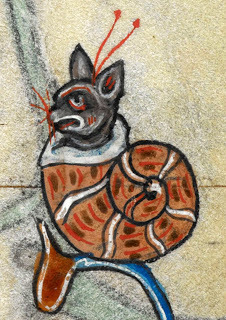 A snail-cat, as delightfully depicted in the Maastricht Hours, an illuminated religious manuscript dating from the early 1300s and originating in the Netherlands (public domain)
A snail-cat, as delightfully depicted in the Maastricht Hours, an illuminated religious manuscript dating from the early 1300s and originating in the Netherlands (public domain)During my earlier researches into snail-cats and other exotic zoological marginalia portrayed in illuminated manuscripts (click here ), I viewed a varied assortment of these latter works online, including the Sankt Florian Psalter. I didn't locate any snail-cats in it, but what I did find was far more startling, and is as follows. In the margin directly above the upper edge of text on the Sankt Florian Psalter's f 28v (click here to view this folio online within the psalter itself) is a very elaborate, colourful decoration consisting of swirling feathers and leaves, clusters of bright golden berries, a bird, a lion, a large human face portrayed in profile…and, partially encircled by a feather and a leaf, a very unusual humanoid figure. He may be cloaked and shown only from the waist up, but just one look at his face is more than enough to reveal just how strange and sinister he is.
To begin with, this eerie entity's skin is a very pale, unhealthy-looking grey shade, his highly domed head is entirely hairless, his arched jet-black eyebrows have a decidedly satanic appearance, and his eyes below them are large and staring. But what sets him well apart from what may otherwise be conceivably identified as some form of stern religious figure wearing a pinkish-red cloak are his extraordinarily long, donkey-like ears, and his noticeably conspicuous teeth, which are not only very large and ghostly-white but also unmistakeably pointed.
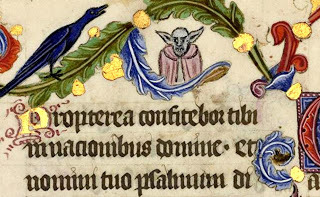 The mysterious neo-Nosferatuan figure depicted on f 28v of the Sankt Florian Psalter (public domain)
The mysterious neo-Nosferatuan figure depicted on f 28v of the Sankt Florian Psalter (public domain)Not so long ago, as mentioned in a recent ShukerNature post (click here ), I watched the 1979 art-house remake (starring Klaus Kinski) of the classic silent German Expressionist horror movie from 1922, Nosferatu: A Symphony of Horror, directed by F.W. Murnau – in which Max Schreck played Count Orlock the vampire, or Nosferatu. And to my amazement, when looking at the weird, grotesque figure standing aloof among the illuminated margin adornments of f 28v from the Sankt Florian Psalter, I realised that he bore an uncanny resemblance to Klaus Kinski's Nosferatu, and even more so to Max Schreck's original version!
The cloak itself (albeit pink rather than black), the extra-long asinine ears, the pale and grim countenance, the domed hairless head, the large staring eyes, and, above all, the white pointed teeth – a veritable vampire of Nosferatuan nature but portrayed in illuminated splendour was gazing back at me from one of the world's most celebrated medieval psalters, a psalter that had been created at least 600 years ago!
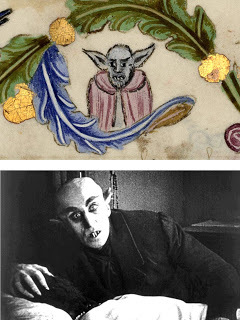 Comparing the cloaked figure from the Sankt Florian Psalter with Max Schreck's portrayal of Nosferatu, the vampirish Count Orlok (public domain)
Comparing the cloaked figure from the Sankt Florian Psalter with Max Schreck's portrayal of Nosferatu, the vampirish Count Orlok (public domain)Never having encountered any mention of this truly bizarre coincidence before, I searched online to discover if anyone else had drawn the same comparison, but could only find a few very scant mentions of the psalter-depicted entity in question on some Polish websites. Like all the best vampires, therefore, the sharp-toothed stranger from the Sankt Florian Psalter had for the most part entirely eluded detection. Only one notable exception came to light, a lengthier, more detailed Polish article that had been written and posted online to advertise the one-day-only public display of this invaluable psalter, on 23 April 2016, at the Palace of the Republic of Poland, in Warsaw.
The article had been uploaded onto the Polona/Blogwebsite on 14 April 2016 (click here to access it), and by an extraordinary coincidence it had been written by none other than Łukasz Kozak, the expert in relation to medieval times and editor at the National Digital Library of Poland whose earlier, equally informative online article regarding the anomalous 'Locust of Kalisz' had been instrumental in guiding my own researches concerning this latter hitherto-obscure cryptid (click here to read my recent ShukerNature blog article documenting it).
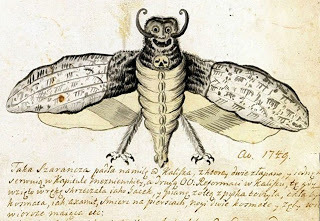 The bizarre 'Locust of Kalisz' drawing, depicting one of many such insects allegedly encountered near this Polish city in 1749 (public domain)
The bizarre 'Locust of Kalisz' drawing, depicting one of many such insects allegedly encountered near this Polish city in 1749 (public domain)What was particularly interesting about Łukasz's article, however, was not only his own comparison of the psalter's mystery figure with Nosferatu, but a second, alternative comparison of it made by him as well. Providing a stark contrast to the darkness epitomised by the fictional Nosferatu, Łukasz noted how the figure also resembled a notable fictitious entity embodying the light side – none other than the Star Wars movie franchise's big-eared, cloak-garbed Yoda!
And indeed, as shown below, there is certainly a resemblance, but less marked, at least in my opinion, than either the similarity between the figure and Nosferatu or the similarity between the earlier-mentioned Smithfield Decretals figure and Yoda. Nevertheless, how can we explain any such resemblances between modern-day fictitious beings and enigmatic, decidedly odd-looking entities depicted in illuminated manuscripts many centuries earlier, and by cloistered monks with little if any first-hand knowledge of the outside world anyway?
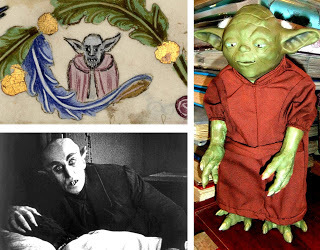 Three-way comparison featuring the cloaked figure from the Sankt Florian Psalter, Max Schreck's portrayal of Nosferatu, and my official model of Yoda (public domain/public domain/© Dr Karl Shuker)
Three-way comparison featuring the cloaked figure from the Sankt Florian Psalter, Max Schreck's portrayal of Nosferatu, and my official model of Yoda (public domain/public domain/© Dr Karl Shuker)As noted in my ShukerNature article dealing with it ( here ), one popular explanation of this Yoda-like entity as depicted in the Smithfield Decretals is that in reality it may represent the devil attired as a demonic doctor of canon law, signifying that some clerics charged to uphold the law were actually corrupt and exploitative of their flock. Alternatively, it might simply represent a devil or demon in human form that is hoping to lure and tempt the unwary away from the paths of righteousness, and I consider it most likely that this or something similar is what the Sankt Florian Psalter's Nosferatu-like figure is intended to represent too. In religious imagery and classical western mythology, the donkey or ass is sometimes seen as an evil beast, so the addition of ass-like ears to a figure is a deft, easily-executed way of conveying visually the inherently malign nature of the figure, irrespective of his religious garb and other outward suggestions of piety and propriety.
Nevertheless, it is nothing if not intriguing to discover just how very like such purposefully ambiguous representations are to analogous versions created entirely independently and several centuries later in time. Then again, when dealing with entities as wily and astute as vampires and Jedi Knights, I suppose that we shouldn't really be surprised at anything!
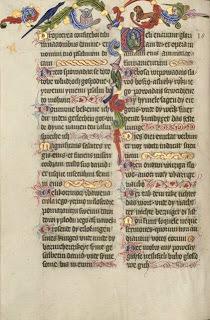 View of the entire f 28v folio from the Sankt Florian Psalter, showing the Nosferatu-like mystery figure in situ (public domain)
View of the entire f 28v folio from the Sankt Florian Psalter, showing the Nosferatu-like mystery figure in situ (public domain)
Published on July 16, 2017 16:09
July 15, 2017
THE LOCUST OF KALISZ? MORE LIKE A DALI-ESQUE DEATHSHEAD!
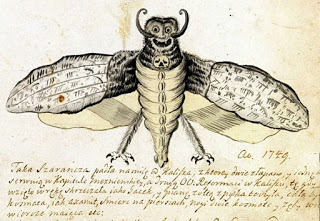 Close-up of the so-called 'Locust of Kalisz' drawing, contained in the scrapbook album compiled and given by friends to General Joachim Daniel von Jauch as a birthday present sometime during the early 1750s (public domain)
Close-up of the so-called 'Locust of Kalisz' drawing, contained in the scrapbook album compiled and given by friends to General Joachim Daniel von Jauch as a birthday present sometime during the early 1750s (public domain)Its many shortcomings and dark aspects notwithstanding, I have long considered the internet to be the greatest cabinet of curiosities ever assembled, a limitless repository replete with wonders and marvels of every conceivable – and inconceivable – kind, all awaiting uncovering and investigation by those with a mind to do so. Over the years, I have documented here on ShukerNature an extremely diverse array of my own cryptozoology-related discoveries made in this manner, of which the present one is just the latest in a very extensive and – at least for me, but I hope for you too – a thoroughly entrancing series with no end in sight, thankfully.
And so it was that while idly browsing last night through the vast virtual art gallery of online images that is freely available via Wikimedia Commons, I typed 'Cryptozoology' in its search engine bar, and instantly called up an entertaining selection of pictures appertaining to mystery beasts. As I browsed through them, I recognised every one with varying degrees of familiarity – until, that is, I came to the extraordinary drawing that opens this current ShukerNature article, and was immediately aware that I had never encountered it before.
As can be seen here , on Wikimedia Commons this drawing has been entitled 'Szarańcza z Kalisza', which translates from Polish as 'Locust of Kalisz', dates from no earlier than 1749, and is accompanied by the following description: 'Zmierzchnica trupia główka ze sztambucha generała Joachima Daniela Jaucha' (very loosely translated via Google Translate as 'the dreaded head of General Joachim Daniel Jauch on paper'). What can this weird insect be, who was Joachim Daniel Jauch, and what is their common history? Needless to say, my sense of cryptozoological curiosity was irresistibly stimulated, and so, in best Sherlockian response, the game was afoot!
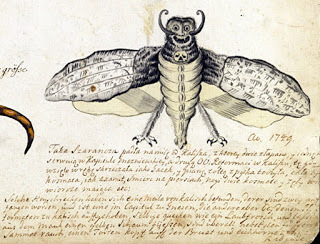 The 'Locust of Kalisz' drawing with its bilingual caption inscribed below it - click to enlarge (public domain)
The 'Locust of Kalisz' drawing with its bilingual caption inscribed below it - click to enlarge (public domain)My first line of investigation was to translate the handwritten caption inscribed directly below the drawing itself. It was present in two separate languages, Old Polish and German, but the script was very faint in both, the ink having long since faded considerably. Happily, however, with great thanks to the much-welcomed translation skills of Facebook friend Miroslav Fismeister and one of his friends, Polish novelist Daniel Koziarski, for the Old Polish version and the much-appreciated assistance of German cryptozoological friend and colleague Markus Bühler for the German version, I am able to provide the following English translation:
The year 1749: A plague of locusts fell a mile from Kalisz, of which two were caught, one was held in Gniezno capital and the other in the OO. Reformation church in Kalisz. When taken in the hand, it was screaming like a bat, yellow foam was coming from its mouth, all of it was hairy, Death on the chest, two hairy legs, squirrel's teeth, etc.
Kalisz is a city in central Poland (and the oldest still existing anywhere in thus country), and Gniezno is a city in central-western Poland that was this country's first capital city. Morever, the OO. Reformation church in Kalisz was conceivably a Reformed Franciscan church and is apparently now the Church of the Holy Family there. Sadly, I currently have no information concerning the fate of the two captured specimens – were they preserved and retained somewhere, I wonder, or simply discarded? Hence I am treating this case as an investigation still in progress. However, combining the verbal description's details with the visual details present in the drawing did swiftly enable me to identify the insect. Albeit exhibiting considerable artistic licence and not a little inaccuracy, whereas the drawing clearly does not portray a locust it was evidently inspired by Acherontia atropos – the deathshead hawk moth, one of Europe's largest lepidopterans (click here for a ShukerNature blog article devoted to this morphologically and behaviourally distinctive species).
True, the characteristic thoracic marking resembling a skull and earning this particular moth its familiar English name was depicted ventrally rather than dorsally in this strange drawing, and in it the insect had been given a grinning human face sporting a decidedly Salvador Dali-esque upward-curving moustache, but this latter feature may have been intended as a whimsical adaptation of the moth's long thick antennae. Indeed, in overall appearance the depicted insect definitely seems to constitute a deliberately comical, humanoid caricature of A. atropos, which would explain why it was only given two legs (but ending in claws, like a moth's, rather than human feet), yet incorporating certain unequivocally Acherontian attributes too, such as the banding upon its rear wings, and its hairy body. Of particular relevance here is that the creature's alleged bat-like screaming – ostensibly nonsensical in relation to a moth – is actually a famous, characteristic feature of this particular moth species For it can emit a shrill, high-pitched squeaking sound, which is created by the moth's powerful inhalation of air into its pharynx, causing a stiffened flap called the epipharynx to vibrate very rapidly (click here for more details).
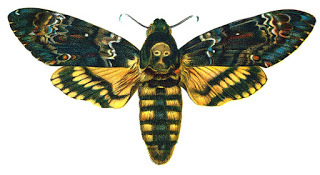 Exquisite 19th-Century illustration of a deathshead hawk moth (public domain)
Exquisite 19th-Century illustration of a deathshead hawk moth (public domain)But what about the description of the drawing assigned to it on Wikimedia Commons? Clearly "the dreaded head" means "the deathshead", referring to the eponymous moth species, but who was General Joachim Daniel Jauch? I soon discovered that he was General Joachim Daniel von Jauch (1688-1754), a German-born architect, civilian engineer, and military man, who had supervised the Baroque development of Warsaw, being responsible for the urban planning and designing or rebuilding of many of its new buildings, and he had also served in the Polish army as an artilleryman, steadily rising up through the ranks. But how was Jauch linked to the humanoid deathshead hawk moth drawing?
In spite of its very striking, memorable appearance, this enigmatic illustration conjured forth a surprisingly scant amount of information when utilising it as the focus of a Google Image-based internet search. However, I am nothing if not persistent (i.e. stubborn!), so eventually I unearthed sufficient details to flesh out its hitherto-opaque history. The drawing originated in a scrapbook-like album filled with all manner of artwork, which was seemingly compiled by some of Jauch's friends as a birthday present for him and presented to him during the early 1750s (precise year not known), i.e. not long before his death.
Containing over 150 exquisite drawings and other art, variously executed in pen-ink, sepia-ink, crayon, pencil, watercolour, and gouache, this unique and very beautiful leather-covered album can be viewed directly online at the website of the National Digital Library of Poland (Biblioteki Cyfrowej Polona), and the humanoid moth (aka Locust of Kalisz) with its accompanying handwritten bilingual caption can be found on p. 95 (click here to view this page and to access the entire album). The diverse artwork includes various architectural designs, sketches and graphics, scenes from mythology, antique sculpture studies, natural history illustrations, and portraits.
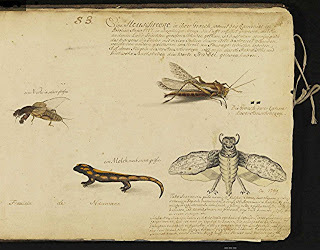 Page 95 from Jauch's album, showing the 'humanoid moth' (aka Locust of Kalisz) drawing in situ (public domain)
Page 95 from Jauch's album, showing the 'humanoid moth' (aka Locust of Kalisz) drawing in situ (public domain)I also discovered a concise, excellent online article in Polish concerning this drawing (click here ), in relation to which Google Translate once again came to my rescue by yielding a workable English version. Dated 11 March 2014, the article was written by Łukasz Kozak, an expert in relation to medieval times and editor at the National Digital Library of Poland, and had been posted on the latter's website. In it, he confirmed that the insect was indeed intended to be a deathshead hawk moth, and documented what I too have written about elsewhere regarding this species' unusual squeaking ability. However, he also provided some very welcome additional information concerning the background history of this intriguing case, including the following details.
As noted earlier, the album is filled with many images, which include numerous full-colour illustrations of plants and animals (such as rodents, birds, reptiles, and insects) that are generally portrayed in a very accurate, naturalistic manner. The artist responsible for these latter illustrations is believed to have been Fraulein de Naumann, as Łukasz had revealed during his own investigation of the moth drawing. She was probably the daughter of architect Johann Christoph von Naumann, who in turn was not only Jauch's predecessor at the architect office where he had worked but also his brother-in-law. Łukasz then went on to reveal the deathshead hawk moth as the species upon which the drawing had been based, and gave some interesting examples from fact and fiction previously unknown to me regarding how the eerie nature of its squeaking had terrified persons in the past who were unfamiliar with this osensibly unnatural ability, thus filling them with superstitious dread.
Łukasz also appears in a short online video in which he looks through Jauch's album, displays the moth drawing, and then discusses it. This video is embedded in an article written by him and first posted on the Newsweek Polska website on 11 February 2015, but unfortunately as he speaks only in Polish I was initially unable to obtain any information from it (click here to access the article and view the video). Happily, however, Katarzyna Bylok, the Polish girlfriend of fellow Fortean/mystery beast investigator Matt Cook, kindly viewed it for me earlier this evening, and the details concerning it that she passed onto me afterwards via Matt confirm that Łukasz was merely reiterating the details that he had previously presented in his March 2014 article. Many thanks indeed to Katarzyna and Matt for kindly assisting me regarding this.
 Still of Łukasz Kozak from Newsweek Polska video (© Łukasz Kozak/Newsweek Polska – reproduced here on a strictly non-commercial Fair Use basis for educational purposes only)
Still of Łukasz Kozak from Newsweek Polska video (© Łukasz Kozak/Newsweek Polska – reproduced here on a strictly non-commercial Fair Use basis for educational purposes only)However, there are certain key issues related to this memorable drawing that remain unresolved - or do they?
Notable among these is why Fraulein de Naumann prepared such a surreal, unrealistic image anyway, bearing in mind that all of her other illustrations in the album were so life-like. Might it have been a humorous caricature of Jauch himself?
The following painting of Jauch was prepared in c.1720, and he is not portrayed in it with a moustache of any kind, but perhaps he grew and maintained one in later years?
 General Joachim Daniel von Jauch, painted in c.1720, artist unknown (public domain)
General Joachim Daniel von Jauch, painted in c.1720, artist unknown (public domain)Alternatively, could it have even been a comical representation of her own father, as she would have known that he and Jauch had worked in the same office? Or perhaps it was not based upon a real person at all, but was just a light-hearted doodle created in jest to add some merriment to the album, bearing in mind that it had been created specifically as a birthday present for him?
Yet another theory that has been suggested by some writers online, including biologist Prof. Stanislaw Czachorowski in an article of 9 February 2014 dealing with the deathshead hawk moth (click here ), and which would certainly explain why it differed so dramatically from the other wildlife illustrations, is also worth considering. Namely, that this drawing was in fact produced by Jauch himself, and was based not upon any sightings of his own but only upon secondhand descriptions or lurid folkloric accounts of the deathshead hawk moth (another reason for its stark inaccuracy), which he interpolated in a blank space on p. 95 of his album alongside the realistic illustrations of Fraulein de Naumann.
As for this drawing's comparably mystifying caption, what are the 'squirrel teeth' referred to in it when describing the moth, and what is the yellow foam seemingly regurgitated by the moth? The caterpillar of the deathshead hawk moth has sizeable mandibles that it will click together and even use to bite aggressors, so these could conceivably be likened to squirrel teeth; but the adult moth only has a slender nectar-imbibing proboscis. Might the phrase instead be a somewhat peculiar allusion to the moth's antennae? In fact, having viewed the following excellent close-up photograph of a deathshead hawk moth's face, the answer now seems clear to me. The 'squirrel teeth' are simply the two ridged, outer edges of the moth's proboscis, which do superficially resemble curved rodent teeth.
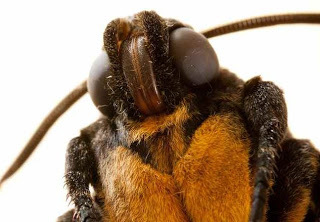 Face of a deathshead hawk moth, showing its ridge-edged proboscis (© owner presently unknown to me - reproduced here on a strictly non-commercial Fair Use educational basis only)
Face of a deathshead hawk moth, showing its ridge-edged proboscis (© owner presently unknown to me - reproduced here on a strictly non-commercial Fair Use educational basis only)It is well known that the caterpillars of hawk moths will regurgitate the sticky (and sometimes toxic) content of their foregut if attacked; but because the mouthparts of caterpillars are very different from those of adult moths, could the latter accomplish such behaviour? Nevertheless, I do recall reading somewhere that certain adult moths will indeed perform this activity as a defence mechanism if need be, so perhaps the deathshead hawk moth is one such species.
Then again, if the drawing itself was intended only as a joke, a spoof, not as a realistic depiction of anything that may truly have appeared near Kalisz in 1749 (and in view of the moth's grinning moustachioed face, this seems ever more likely the more I reflect upon it), maybe the caption was composed in an equally tongue-in-cheek manner and should therefore be taken no more seriously than the drawing.
Equally mystifying is why the insect in the drawing was referred to as a locust, given that it looked nothing like one and was indisputably inspired by a deathshead hawk moth. However, the implication from the drawing's caption is that in 1749 a sizeable number of such insects appeared near Kalisz, and other Polish accounts concerning this incident that I have read online support that implication, so it seems plausible that the term 'locust' was being applied not literally but figuratively, an allusion to the large numbers of this insect that had appeared near the city that year.
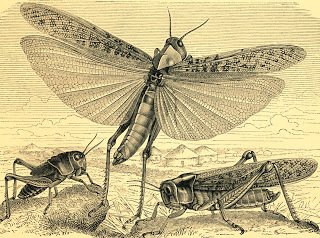 A 19th-Century illustration of locusts (public domain)
A 19th-Century illustration of locusts (public domain)Even so, this is still odd, because although I have read occasional accounts of veritable swarms of certain hawk moth species occurring in various localities down through the ages, I haven't read anything comparable relating specifically to the deathshead hawk moth. Having said that: in my ShukerNaturearticle on this species (click here ), I do refer to a singular incident in which approximately 300 specimens were attracted to a single beehive within a short period of time. The reason for this was that the deathshead has a great liking for honey, so much so in fact that some researchers have even suggested that its uncanny squeaking ability may actually be an attempt to impersonate the specific sound that a queen bee produces to keep her workers passive, and thence allow the moth to enter the hive and consume its honey without being attacked by the hive's worker bees. Consequently, in exceptional circumstances large numbers of deathsheads may indeed occur. So although I haven't been able as yet to trace any corroboration that is independent of the moth drawing, perhaps one such occurrence took place near Kalisz, Poland, during 1749.
Clearly there is still much to uncover regarding this fascinating case, but what I have provided here so far would already appear to be the most detailed account of it ever presented in English. So, now that its curious story is readily accessible to a much greater audience than before, perhaps additional details will be forthcoming from readers, to plug the gaps remaining in its history. Consequently, as I noted earlier here, I consider this article and investigation of mine to be a work in progress, so I would be extremely grateful to receive any supplementary information relating to it. And as is always true with my researches, all such submissions will be fully credited by me if utilised in updates to this article.
Incidentally, there is actually a Facebook page, in Polish, devoted to the humanoid moth drawing from Jauch's album – entitled 'Szarańcza z Kalisza', it contains various relevant posts and comments, plus a delightful animated GIF of this drawing, created by Mieszko Saktura. Click here to visit and Like its page (I have).
 Polish postage stamp depicting the deathshead hawk moth (public domain)
Polish postage stamp depicting the deathshead hawk moth (public domain)And finally: for another ShukerNature blog article concerning an equally bizarre illustration of an alleged locust that clearly was nothing of the kind, be sure to click here and read all about the extraordinary locust dragon of Nicolaes de Bruyn from 1594.
 The original, truly bizarre 1594 illustration by Nicolaes de Bruyn of an apparent locust dragon (public domain)
The original, truly bizarre 1594 illustration by Nicolaes de Bruyn of an apparent locust dragon (public domain)
Published on July 15, 2017 15:57
July 8, 2017
IS THE OZENKADNOOK TIGER A CARDBOARD CRYPTID?
 The (in)famous Ozenkadnook tiger photograph (copyright owner's identity presently ambiguous, it would seem - see below - although traditionally attributed to Rilla Martin)
The (in)famous Ozenkadnook tiger photograph (copyright owner's identity presently ambiguous, it would seem - see below - although traditionally attributed to Rilla Martin)One of cryptozoology's most iconic images is the so-called Ozenkadnook Tiger Photograph, reproduced above. It depicts a large, seemingly dark-bodied, white-striped Australian mystery beast supposedly snapped in b/w during 1964 by Melbourne-based Rilla Martin while holidaying in Victoria. She had apparently been driving along a dirt track near Ozenkadnook when she saw the creature at the edge of some woods, and after stopping the car she managed to snap a single photo of it before it ran off.
In typical cryptozoological tradition, the photo's depiction of the beast is far from clear; but as its burly head looks vaguely dog-like, it has inspired various Aussie cryptid enthusiasts to speculate that the striped creature may be a living mainland thylacine Thylacinus cynocephalus. Yet this externally wolf-like marsupial officially died out here over 3,000 years ago, i.e. long before its official extinction on Tasmania in 1936.
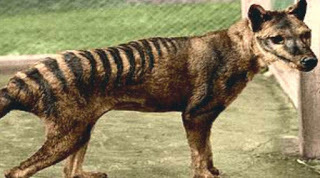 A pre-1936 public domain photograph of a living Tasmanian thylacine in captivity, colourised by person(s) unknown to me; found online (public domain/colourising © unknown to me)
A pre-1936 public domain photograph of a living Tasmanian thylacine in captivity, colourised by person(s) unknown to me; found online (public domain/colourising © unknown to me)Moreover, the bizarre reverse-striping pattern exhibited by the photographed creature bears no resemblance to the thylacine's striping, and has led others to suggest that these markings are not genuine features of it at all, but merely constitute reflected sunlight.
Having said that, such a situation would not in itself automatically exclude the thylacine from consideration as an identity for this mystery beast, as succinctly demonstrated by the following very pertinent photograph:
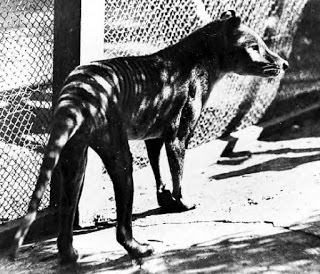 Pre-1936 photograph of a captive thylacine dappled by sunlight and somewhat resembling the photographed Ozenkadnook tiger (public domain)
Pre-1936 photograph of a captive thylacine dappled by sunlight and somewhat resembling the photographed Ozenkadnook tiger (public domain)Less likely than a thylacine explanation, but suggested by some mystery beast fans, is that the Ozenkadnook tiger was a living marsupial lion Thylacoleo carnifex, which according to the currently-documented fossil record became extinct around 50,000 years ago (although there are a couple of intriguing aboriginal petroglyphs in existence that depict a mysterious beast very reminiscent of Thylacoleobut which are only around 6,500 years old, thereby indicating if identified correctly that this singular species did persist into relatively recent times).
Yet even if has survived right up to the present day undiscovered by science (and popularly proposed by cryptozoologists as the identity of an elusive feline cryptid known as the yarri or Queensland marsupial tiger), its morphology as deduced from fossil finds differs markedly from that of the creature in the photograph.
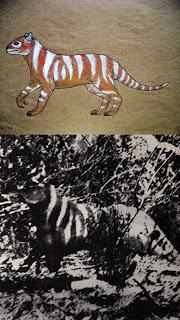 Specially prepared colour drawing of the yarri or Queensland tiger to which the reverse striping coat pattern ostensibly exhibited by the Ozenkadnook tiger has been deliberately applied, in order to show how the former cryptid might look if it were one and the same species as the latter cryptid, depicted below it (© Markus Bühler / copyright owner's identity presently ambiguous, it would seem - see below - although traditionally attributed to Rilla Martin)
Specially prepared colour drawing of the yarri or Queensland tiger to which the reverse striping coat pattern ostensibly exhibited by the Ozenkadnook tiger has been deliberately applied, in order to show how the former cryptid might look if it were one and the same species as the latter cryptid, depicted below it (© Markus Bühler / copyright owner's identity presently ambiguous, it would seem - see below - although traditionally attributed to Rilla Martin)Less contentious options on offer include a dingo or a domestic dog, whereas more sceptical views have leaned toward an unspecified hoax of some kind. With no consensus of opinion surfacing, the controversy as to what Martin's photo really depicts has rumbled on for over 50 years, but in a recent newspaper article (click here ) a remarkable new allegation was made.
Namely, that the beast was nothing more than a large cardboard cut-out, created, painted with stripes, and then photographed in the bush by the father of one Bill Leak - a recently-deceased newspaper cartoonist – with a friend. Bill's father was apparently well known for his love of practical jokes, and the allegation was made in The Australian on 24 March 2017 by 'Jack the Insider', aka columnist Peter Hoysted, who had known Bill and had included this claim as part of a memorial article regarding him.
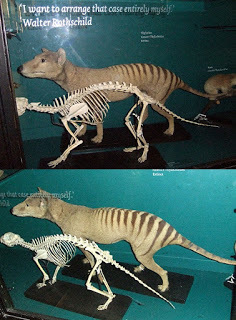 A taxiderm Tasmanian thylacine and a thylacine skeleton at Tring Natural History Museum, two views (© Dr Karl Shuker)
A taxiderm Tasmanian thylacine and a thylacine skeleton at Tring Natural History Museum, two views (© Dr Karl Shuker)Supposedly, the hoax was only staged and the photo snapped as a joke to show some friends, but allegedly the photo somehow reached the media and soon attracted appreciable global attention, at which point Leak Snr became nervous that the truth would be exposed, so he destroyed the cut-out and told his son never to speak to anyone about it. Yet clearly he did, at least after his father's death, hence Hoysted's report following Bill's own death.
Various subsequent coverages have seized upon this 'confession by proxy' as proof that the Ozenkadnook Tiger photo is truly a hoax and should therefore be dismissed as being of any potential cryptozoological significance. However, in my opinion such an attitude overlooks two glaring and decidedly worrying shortcomings concerning Hoysted's recent revelation.
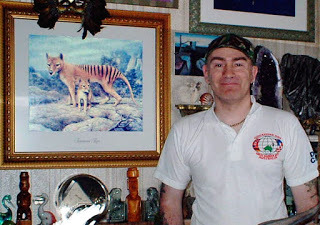 Alongside a thylacine picture in my study (© Dr Karl Shuker)
Alongside a thylacine picture in my study (© Dr Karl Shuker)Firstly, the revelation is entirely anecdotal (and not even first-hand), as there seems to be no physical, tangible evidence substantiating it. True, in an update of 20 August 2010 to an article of his own concerning this perplexing picture that he had originally posted on his Tetrapod Zoology blog two days earlier (click here to read it), British palaeontologist and cryptozoology chronicler Dr Darren Naish did point out an unidentified object in it that he interpreted as possibly being an artificial supporting structure, which if so would be consistent with the creature being merely a cardboard cut-out. But obviously this interpretation is merely a personal opinion, not a verified fact.
Sadly, however, opinions are all that can be offered regarding what may or may not be present in this photo because, very regrettably, the original negative was lost back in the mid-1960s when it was loaned to a newspaper. Consequently, there is no opportunity to subject it to the high-tech type of photographic analysis available nowadays.
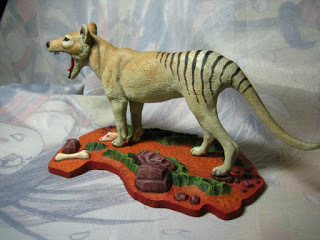 Outstanding thylacine model sculpted and painted by Facebook friend Jeff Johnson (© Jeff Johnson)
Outstanding thylacine model sculpted and painted by Facebook friend Jeff Johnson (© Jeff Johnson)Secondly, Hoysted's revelation signally yet inexplicably fails to include any mention of Rilla Martin, the person who for the past five decades has been the name directly associated with the snapping of this photo, and who has even been interviewed by the media concerning it. Indeed, as noted by Darren in his 2010 article, although the photo is popularly known as the Ozenkadnook tiger photo it is even better known, at least by some, as the Rilla Martin photo, thus emphasising just how closely associated she is with it.
In a new Tetrapod Zoology article concerning the Ozenkadnook tiger photo, documenting Hoysted's newspaper article and posted online on 29 March 2017 (click here ), Darren mentioned that he had personally asked Hoysted how Martin had become involved if it was actually Bill Leak's father who had snapped the photo, not her. In response, Hoysted had "surmised that Martin somehow agreed to take credit for the photo, but other details are as yet unclear". In short, this is just Hoysted's personal opinion, uncorroborated by any tangible evidence.
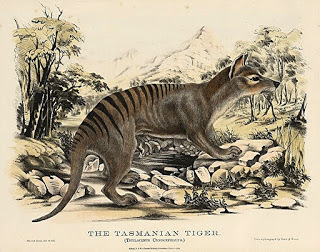 Thylacine (aka Tasmanian tiger) illustration in eminent 19th-Century Australian zoologist Gerard Krefft's opus The Mammals of Australia, 1871 (public domain)
Thylacine (aka Tasmanian tiger) illustration in eminent 19th-Century Australian zoologist Gerard Krefft's opus The Mammals of Australia, 1871 (public domain)Consequently, until – if ever – these two fundamental flaws can be resolved, I for one shall continue to consider as unproven this latest allegation regarding the enigmatic Ozenkadnook Tiger Photograph. In situations of this kind, I always ask myself one simple question: if unsubstantiated claims like these were being put forward in support of a cryptid's status as a reality, rather than in support of a cryptid's status as a hoax, would they be so readily accepted by sceptics? And I think that we all know the answer to that question.
For more information regarding this Australian cryptid as well as related musings concerning putative surviving mainland thylacines and marsupial lions, be sure to check out my books Mystery Cats of the World , Cats of Magic, Mythology, and Mystery , and Still In Search Of Prehistoric Survivors .

Published on July 08, 2017 11:06
Karl Shuker's Blog
- Karl Shuker's profile
- 45 followers
Karl Shuker isn't a Goodreads Author
(yet),
but they
do have a blog,
so here are some recent posts imported from
their feed.



